Women's Literacy in Kenya: Are We on Track to Achieving Education For All (EFA)?
VerifiedAdded on 2023/06/15
|23
|7255
|445
AI Summary
This article discusses the gender disparity in Kenya's education system, particularly in secondary education for girls, and the challenges faced in achieving Education For All (EFA) goals. It analyzes the frameworks of modernization and empowerment, and highlights the need for removing the gender disparity in the education system of Kenya, particularly to bring literacy to women.
Contribute Materials
Your contribution can guide someone’s learning journey. Share your
documents today.

qwertyuiopasdfghjklzxcvbnmqwertyui
opasdfghjklzxcvbnmqwertyuiopasdfgh
jklzxcvbnmqwertyuiopasdfghjklzxcvb
nmqwertyuiopasdfghjklzxcvbnmqwer
tyuiopasdfghjklzxcvbnmqwertyuiopas
dfghjklzxcvbnmqwertyuiopasdfghjklzx
cvbnmqwertyuiopasdfghjklzxcvbnmq
wertyuiopasdfghjklzxcvbnmqwertyuio
pasdfghjklzxcvbnmqwertyuiopasdfghj
Women's literacy in Kenya
Are we on track to achieving Education For All (EFA)?
17-Feb-18
(Student Details: )
opasdfghjklzxcvbnmqwertyuiopasdfgh
jklzxcvbnmqwertyuiopasdfghjklzxcvb
nmqwertyuiopasdfghjklzxcvbnmqwer
tyuiopasdfghjklzxcvbnmqwertyuiopas
dfghjklzxcvbnmqwertyuiopasdfghjklzx
cvbnmqwertyuiopasdfghjklzxcvbnmq
wertyuiopasdfghjklzxcvbnmqwertyuio
pasdfghjklzxcvbnmqwertyuiopasdfghj
Women's literacy in Kenya
Are we on track to achieving Education For All (EFA)?
17-Feb-18
(Student Details: )
Secure Best Marks with AI Grader
Need help grading? Try our AI Grader for instant feedback on your assignments.

Women's literacy in Kenya
Introduction
Education is an enlightening experience whereby the systematic instructions are given at the
teaching place. Through the use of techniques like training, teaching, directed research,
storytelling and discussions, the individuals are taught about different things, which help in their
overall development (Moss, 2011). An education person is not only able to grow themselves, but
is also able to reciprocate the growth in others, and this is particularly true in context of women.
It has documented the evidence regarding the female education being amongst the most
significant forces for the development. There have been common views that the educated
mothers are able to raise a better, smaller and healthier family, and can be more productive in
their homes, and also in their workplaces (Hill and King, 1995).
Even though women form half of mankind, they are two thirds in terms of illiterates of the world
(Mackenzie, 1993). This is the reason why a higher number of males, in comparison to females,
continue to go to school and climb the educational ladder in the less industrialized economies of
Africa, which includes Kenya (Mueller, 1990). Africa has around 64% illiterate women; and
Kenya has more than sixty percent of women as illiterates (Republic of Kenya, 1988). Owing to
the structural adjustment programmes, the situation has remained more or less the same since
late 1980’s. This has been coupled with budget cuts over the year in education, which has
resulted in the education of women and girls being affected in an adverse manner. The majority
of societies across the globe have a preference of educating the boys in comparison to the girls
and this is true for the poor families (Kibera, 2002).
Education For All is a global commitment which aims to provide quality basic education to all
the adults, youth and the children. Amongst the 164 governments which pledged to attain the
Page 2
Introduction
Education is an enlightening experience whereby the systematic instructions are given at the
teaching place. Through the use of techniques like training, teaching, directed research,
storytelling and discussions, the individuals are taught about different things, which help in their
overall development (Moss, 2011). An education person is not only able to grow themselves, but
is also able to reciprocate the growth in others, and this is particularly true in context of women.
It has documented the evidence regarding the female education being amongst the most
significant forces for the development. There have been common views that the educated
mothers are able to raise a better, smaller and healthier family, and can be more productive in
their homes, and also in their workplaces (Hill and King, 1995).
Even though women form half of mankind, they are two thirds in terms of illiterates of the world
(Mackenzie, 1993). This is the reason why a higher number of males, in comparison to females,
continue to go to school and climb the educational ladder in the less industrialized economies of
Africa, which includes Kenya (Mueller, 1990). Africa has around 64% illiterate women; and
Kenya has more than sixty percent of women as illiterates (Republic of Kenya, 1988). Owing to
the structural adjustment programmes, the situation has remained more or less the same since
late 1980’s. This has been coupled with budget cuts over the year in education, which has
resulted in the education of women and girls being affected in an adverse manner. The majority
of societies across the globe have a preference of educating the boys in comparison to the girls
and this is true for the poor families (Kibera, 2002).
Education For All is a global commitment which aims to provide quality basic education to all
the adults, youth and the children. Amongst the 164 governments which pledged to attain the
Page 2
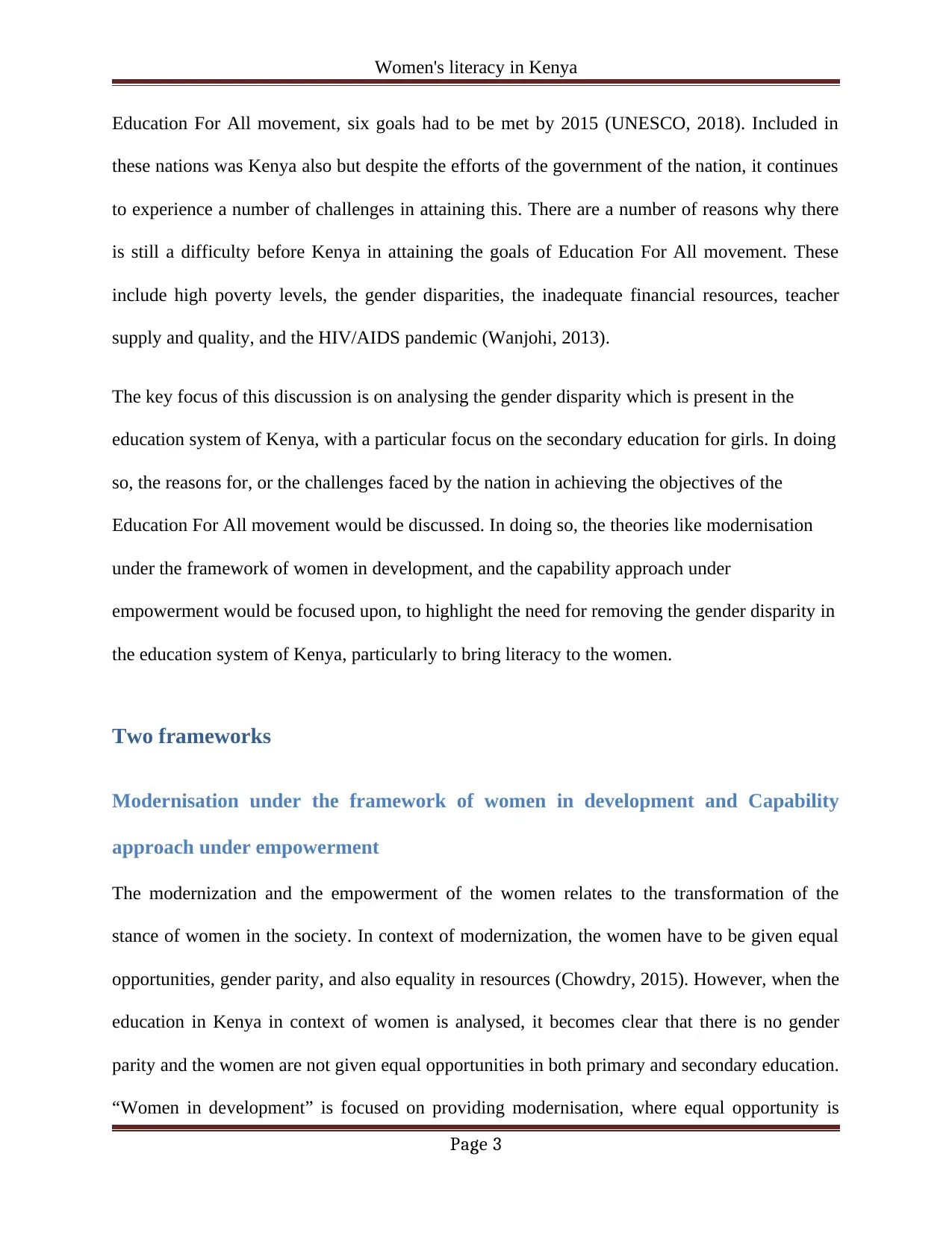
Women's literacy in Kenya
Education For All movement, six goals had to be met by 2015 (UNESCO, 2018). Included in
these nations was Kenya also but despite the efforts of the government of the nation, it continues
to experience a number of challenges in attaining this. There are a number of reasons why there
is still a difficulty before Kenya in attaining the goals of Education For All movement. These
include high poverty levels, the gender disparities, the inadequate financial resources, teacher
supply and quality, and the HIV/AIDS pandemic (Wanjohi, 2013).
The key focus of this discussion is on analysing the gender disparity which is present in the
education system of Kenya, with a particular focus on the secondary education for girls. In doing
so, the reasons for, or the challenges faced by the nation in achieving the objectives of the
Education For All movement would be discussed. In doing so, the theories like modernisation
under the framework of women in development, and the capability approach under
empowerment would be focused upon, to highlight the need for removing the gender disparity in
the education system of Kenya, particularly to bring literacy to the women.
Two frameworks
Modernisation under the framework of women in development and Capability
approach under empowerment
The modernization and the empowerment of the women relates to the transformation of the
stance of women in the society. In context of modernization, the women have to be given equal
opportunities, gender parity, and also equality in resources (Chowdry, 2015). However, when the
education in Kenya in context of women is analysed, it becomes clear that there is no gender
parity and the women are not given equal opportunities in both primary and secondary education.
“Women in development” is focused on providing modernisation, where equal opportunity is
Page 3
Education For All movement, six goals had to be met by 2015 (UNESCO, 2018). Included in
these nations was Kenya also but despite the efforts of the government of the nation, it continues
to experience a number of challenges in attaining this. There are a number of reasons why there
is still a difficulty before Kenya in attaining the goals of Education For All movement. These
include high poverty levels, the gender disparities, the inadequate financial resources, teacher
supply and quality, and the HIV/AIDS pandemic (Wanjohi, 2013).
The key focus of this discussion is on analysing the gender disparity which is present in the
education system of Kenya, with a particular focus on the secondary education for girls. In doing
so, the reasons for, or the challenges faced by the nation in achieving the objectives of the
Education For All movement would be discussed. In doing so, the theories like modernisation
under the framework of women in development, and the capability approach under
empowerment would be focused upon, to highlight the need for removing the gender disparity in
the education system of Kenya, particularly to bring literacy to the women.
Two frameworks
Modernisation under the framework of women in development and Capability
approach under empowerment
The modernization and the empowerment of the women relates to the transformation of the
stance of women in the society. In context of modernization, the women have to be given equal
opportunities, gender parity, and also equality in resources (Chowdry, 2015). However, when the
education in Kenya in context of women is analysed, it becomes clear that there is no gender
parity and the women are not given equal opportunities in both primary and secondary education.
“Women in development” is focused on providing modernisation, where equal opportunity is
Page 3
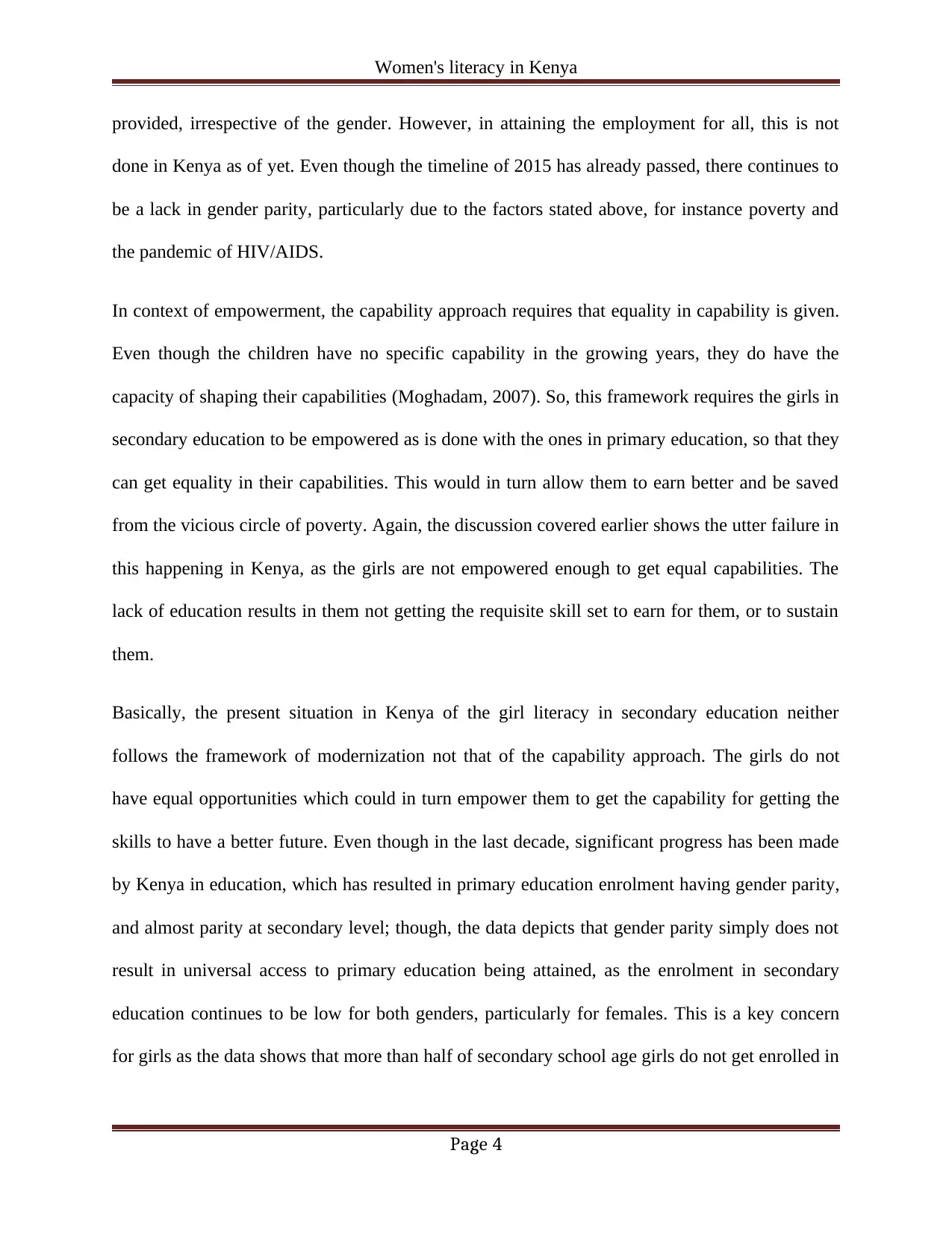
Women's literacy in Kenya
provided, irrespective of the gender. However, in attaining the employment for all, this is not
done in Kenya as of yet. Even though the timeline of 2015 has already passed, there continues to
be a lack in gender parity, particularly due to the factors stated above, for instance poverty and
the pandemic of HIV/AIDS.
In context of empowerment, the capability approach requires that equality in capability is given.
Even though the children have no specific capability in the growing years, they do have the
capacity of shaping their capabilities (Moghadam, 2007). So, this framework requires the girls in
secondary education to be empowered as is done with the ones in primary education, so that they
can get equality in their capabilities. This would in turn allow them to earn better and be saved
from the vicious circle of poverty. Again, the discussion covered earlier shows the utter failure in
this happening in Kenya, as the girls are not empowered enough to get equal capabilities. The
lack of education results in them not getting the requisite skill set to earn for them, or to sustain
them.
Basically, the present situation in Kenya of the girl literacy in secondary education neither
follows the framework of modernization not that of the capability approach. The girls do not
have equal opportunities which could in turn empower them to get the capability for getting the
skills to have a better future. Even though in the last decade, significant progress has been made
by Kenya in education, which has resulted in primary education enrolment having gender parity,
and almost parity at secondary level; though, the data depicts that gender parity simply does not
result in universal access to primary education being attained, as the enrolment in secondary
education continues to be low for both genders, particularly for females. This is a key concern
for girls as the data shows that more than half of secondary school age girls do not get enrolled in
Page 4
provided, irrespective of the gender. However, in attaining the employment for all, this is not
done in Kenya as of yet. Even though the timeline of 2015 has already passed, there continues to
be a lack in gender parity, particularly due to the factors stated above, for instance poverty and
the pandemic of HIV/AIDS.
In context of empowerment, the capability approach requires that equality in capability is given.
Even though the children have no specific capability in the growing years, they do have the
capacity of shaping their capabilities (Moghadam, 2007). So, this framework requires the girls in
secondary education to be empowered as is done with the ones in primary education, so that they
can get equality in their capabilities. This would in turn allow them to earn better and be saved
from the vicious circle of poverty. Again, the discussion covered earlier shows the utter failure in
this happening in Kenya, as the girls are not empowered enough to get equal capabilities. The
lack of education results in them not getting the requisite skill set to earn for them, or to sustain
them.
Basically, the present situation in Kenya of the girl literacy in secondary education neither
follows the framework of modernization not that of the capability approach. The girls do not
have equal opportunities which could in turn empower them to get the capability for getting the
skills to have a better future. Even though in the last decade, significant progress has been made
by Kenya in education, which has resulted in primary education enrolment having gender parity,
and almost parity at secondary level; though, the data depicts that gender parity simply does not
result in universal access to primary education being attained, as the enrolment in secondary
education continues to be low for both genders, particularly for females. This is a key concern
for girls as the data shows that more than half of secondary school age girls do not get enrolled in
Page 4
Secure Best Marks with AI Grader
Need help grading? Try our AI Grader for instant feedback on your assignments.
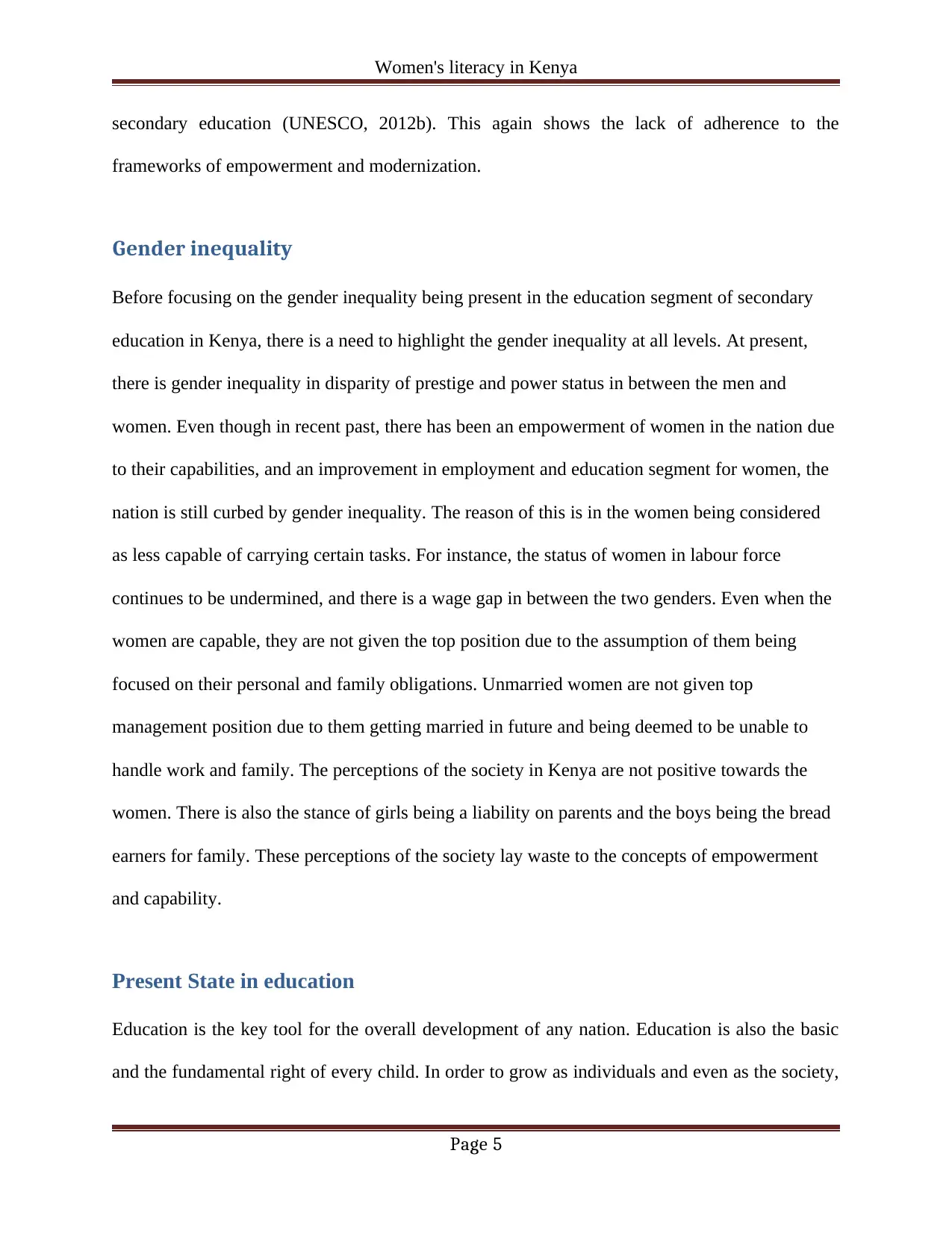
Women's literacy in Kenya
secondary education (UNESCO, 2012b). This again shows the lack of adherence to the
frameworks of empowerment and modernization.
Gender inequality
Before focusing on the gender inequality being present in the education segment of secondary
education in Kenya, there is a need to highlight the gender inequality at all levels. At present,
there is gender inequality in disparity of prestige and power status in between the men and
women. Even though in recent past, there has been an empowerment of women in the nation due
to their capabilities, and an improvement in employment and education segment for women, the
nation is still curbed by gender inequality. The reason of this is in the women being considered
as less capable of carrying certain tasks. For instance, the status of women in labour force
continues to be undermined, and there is a wage gap in between the two genders. Even when the
women are capable, they are not given the top position due to the assumption of them being
focused on their personal and family obligations. Unmarried women are not given top
management position due to them getting married in future and being deemed to be unable to
handle work and family. The perceptions of the society in Kenya are not positive towards the
women. There is also the stance of girls being a liability on parents and the boys being the bread
earners for family. These perceptions of the society lay waste to the concepts of empowerment
and capability.
Present State in education
Education is the key tool for the overall development of any nation. Education is also the basic
and the fundamental right of every child. In order to grow as individuals and even as the society,
Page 5
secondary education (UNESCO, 2012b). This again shows the lack of adherence to the
frameworks of empowerment and modernization.
Gender inequality
Before focusing on the gender inequality being present in the education segment of secondary
education in Kenya, there is a need to highlight the gender inequality at all levels. At present,
there is gender inequality in disparity of prestige and power status in between the men and
women. Even though in recent past, there has been an empowerment of women in the nation due
to their capabilities, and an improvement in employment and education segment for women, the
nation is still curbed by gender inequality. The reason of this is in the women being considered
as less capable of carrying certain tasks. For instance, the status of women in labour force
continues to be undermined, and there is a wage gap in between the two genders. Even when the
women are capable, they are not given the top position due to the assumption of them being
focused on their personal and family obligations. Unmarried women are not given top
management position due to them getting married in future and being deemed to be unable to
handle work and family. The perceptions of the society in Kenya are not positive towards the
women. There is also the stance of girls being a liability on parents and the boys being the bread
earners for family. These perceptions of the society lay waste to the concepts of empowerment
and capability.
Present State in education
Education is the key tool for the overall development of any nation. Education is also the basic
and the fundamental right of every child. In order to grow as individuals and even as the society,
Page 5
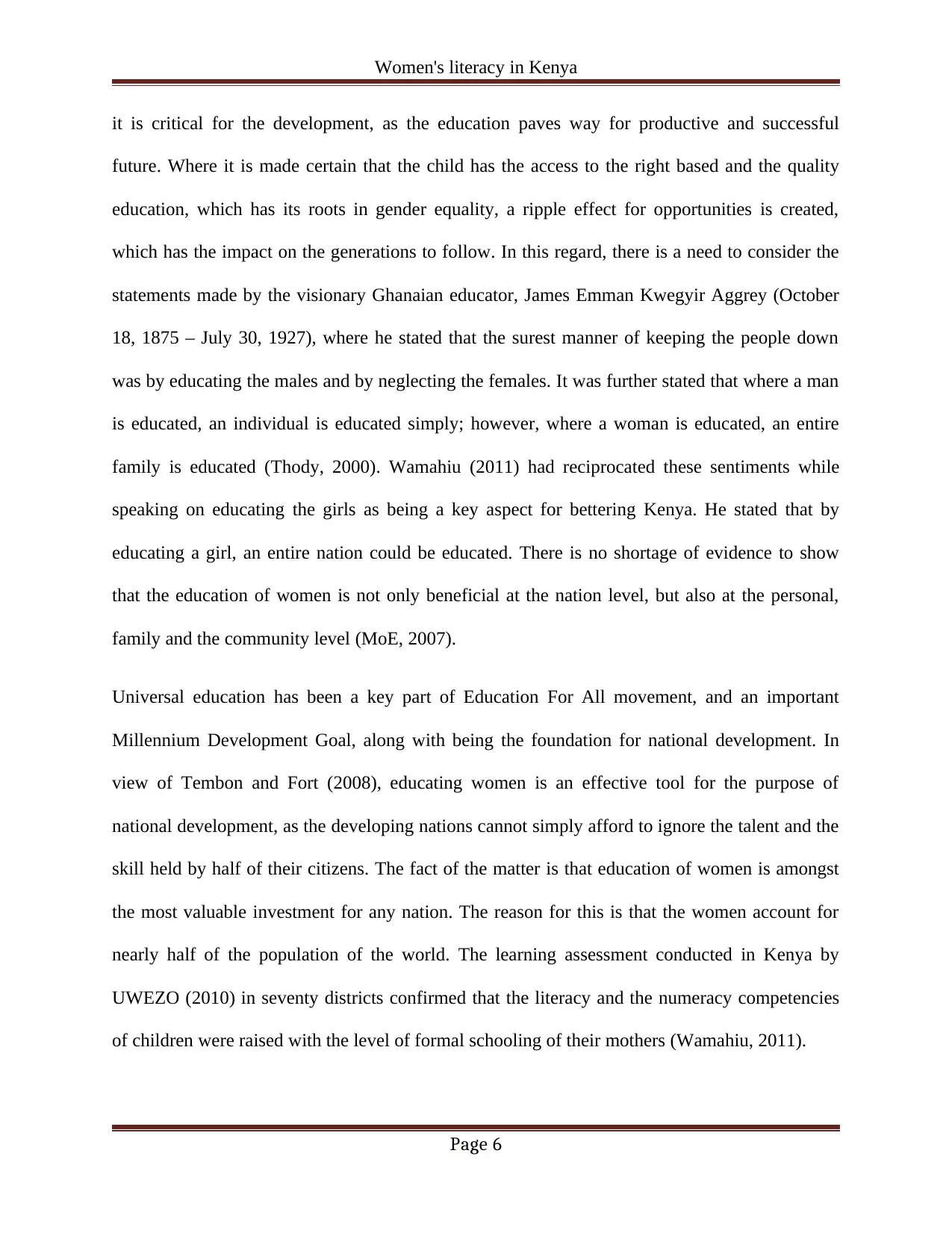
Women's literacy in Kenya
it is critical for the development, as the education paves way for productive and successful
future. Where it is made certain that the child has the access to the right based and the quality
education, which has its roots in gender equality, a ripple effect for opportunities is created,
which has the impact on the generations to follow. In this regard, there is a need to consider the
statements made by the visionary Ghanaian educator, James Emman Kwegyir Aggrey (October
18, 1875 – July 30, 1927), where he stated that the surest manner of keeping the people down
was by educating the males and by neglecting the females. It was further stated that where a man
is educated, an individual is educated simply; however, where a woman is educated, an entire
family is educated (Thody, 2000). Wamahiu (2011) had reciprocated these sentiments while
speaking on educating the girls as being a key aspect for bettering Kenya. He stated that by
educating a girl, an entire nation could be educated. There is no shortage of evidence to show
that the education of women is not only beneficial at the nation level, but also at the personal,
family and the community level (MoE, 2007).
Universal education has been a key part of Education For All movement, and an important
Millennium Development Goal, along with being the foundation for national development. In
view of Tembon and Fort (2008), educating women is an effective tool for the purpose of
national development, as the developing nations cannot simply afford to ignore the talent and the
skill held by half of their citizens. The fact of the matter is that education of women is amongst
the most valuable investment for any nation. The reason for this is that the women account for
nearly half of the population of the world. The learning assessment conducted in Kenya by
UWEZO (2010) in seventy districts confirmed that the literacy and the numeracy competencies
of children were raised with the level of formal schooling of their mothers (Wamahiu, 2011).
Page 6
it is critical for the development, as the education paves way for productive and successful
future. Where it is made certain that the child has the access to the right based and the quality
education, which has its roots in gender equality, a ripple effect for opportunities is created,
which has the impact on the generations to follow. In this regard, there is a need to consider the
statements made by the visionary Ghanaian educator, James Emman Kwegyir Aggrey (October
18, 1875 – July 30, 1927), where he stated that the surest manner of keeping the people down
was by educating the males and by neglecting the females. It was further stated that where a man
is educated, an individual is educated simply; however, where a woman is educated, an entire
family is educated (Thody, 2000). Wamahiu (2011) had reciprocated these sentiments while
speaking on educating the girls as being a key aspect for bettering Kenya. He stated that by
educating a girl, an entire nation could be educated. There is no shortage of evidence to show
that the education of women is not only beneficial at the nation level, but also at the personal,
family and the community level (MoE, 2007).
Universal education has been a key part of Education For All movement, and an important
Millennium Development Goal, along with being the foundation for national development. In
view of Tembon and Fort (2008), educating women is an effective tool for the purpose of
national development, as the developing nations cannot simply afford to ignore the talent and the
skill held by half of their citizens. The fact of the matter is that education of women is amongst
the most valuable investment for any nation. The reason for this is that the women account for
nearly half of the population of the world. The learning assessment conducted in Kenya by
UWEZO (2010) in seventy districts confirmed that the literacy and the numeracy competencies
of children were raised with the level of formal schooling of their mothers (Wamahiu, 2011).
Page 6
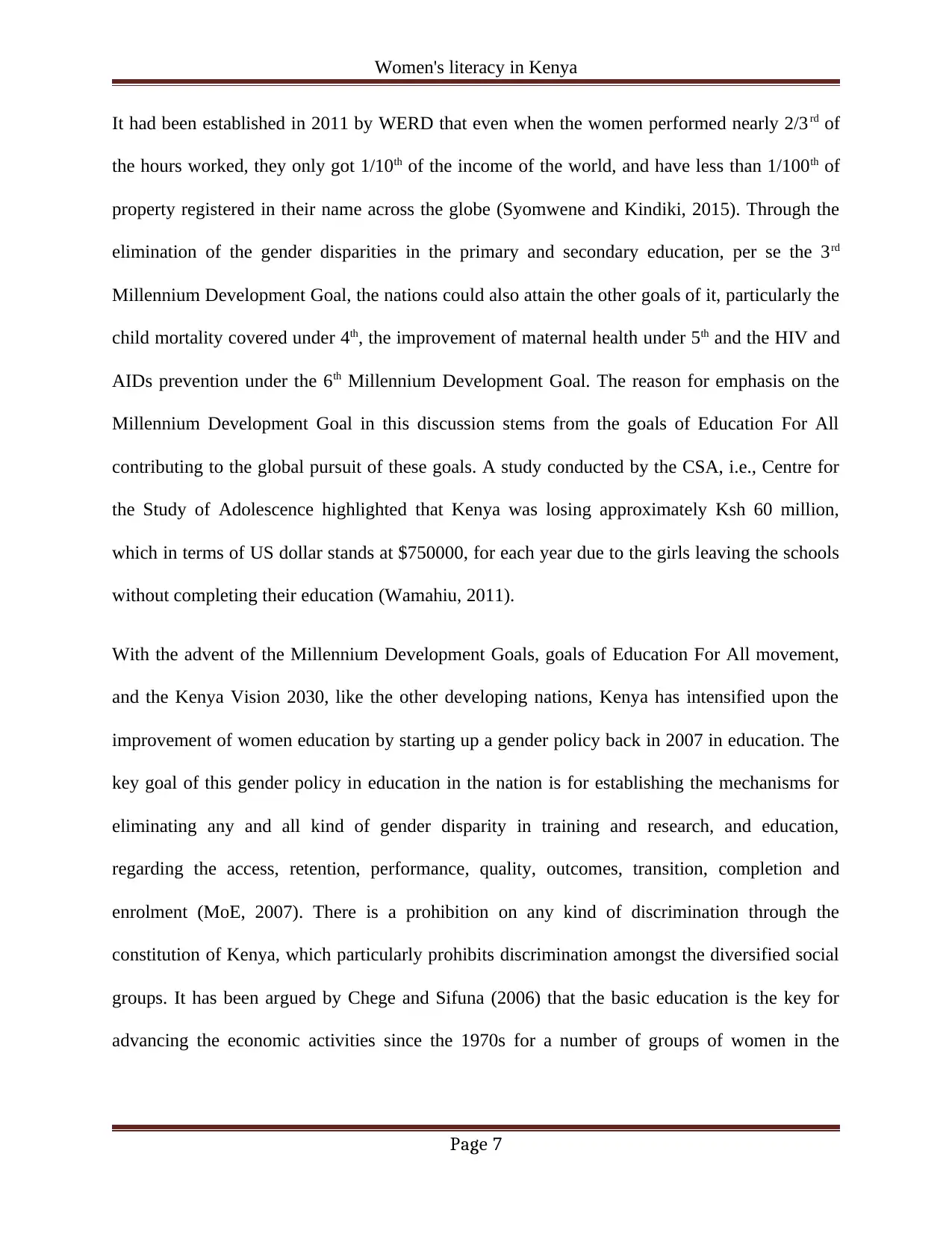
Women's literacy in Kenya
It had been established in 2011 by WERD that even when the women performed nearly 2/3rd of
the hours worked, they only got 1/10th of the income of the world, and have less than 1/100th of
property registered in their name across the globe (Syomwene and Kindiki, 2015). Through the
elimination of the gender disparities in the primary and secondary education, per se the 3rd
Millennium Development Goal, the nations could also attain the other goals of it, particularly the
child mortality covered under 4th, the improvement of maternal health under 5th and the HIV and
AIDs prevention under the 6th Millennium Development Goal. The reason for emphasis on the
Millennium Development Goal in this discussion stems from the goals of Education For All
contributing to the global pursuit of these goals. A study conducted by the CSA, i.e., Centre for
the Study of Adolescence highlighted that Kenya was losing approximately Ksh 60 million,
which in terms of US dollar stands at $750000, for each year due to the girls leaving the schools
without completing their education (Wamahiu, 2011).
With the advent of the Millennium Development Goals, goals of Education For All movement,
and the Kenya Vision 2030, like the other developing nations, Kenya has intensified upon the
improvement of women education by starting up a gender policy back in 2007 in education. The
key goal of this gender policy in education in the nation is for establishing the mechanisms for
eliminating any and all kind of gender disparity in training and research, and education,
regarding the access, retention, performance, quality, outcomes, transition, completion and
enrolment (MoE, 2007). There is a prohibition on any kind of discrimination through the
constitution of Kenya, which particularly prohibits discrimination amongst the diversified social
groups. It has been argued by Chege and Sifuna (2006) that the basic education is the key for
advancing the economic activities since the 1970s for a number of groups of women in the
Page 7
It had been established in 2011 by WERD that even when the women performed nearly 2/3rd of
the hours worked, they only got 1/10th of the income of the world, and have less than 1/100th of
property registered in their name across the globe (Syomwene and Kindiki, 2015). Through the
elimination of the gender disparities in the primary and secondary education, per se the 3rd
Millennium Development Goal, the nations could also attain the other goals of it, particularly the
child mortality covered under 4th, the improvement of maternal health under 5th and the HIV and
AIDs prevention under the 6th Millennium Development Goal. The reason for emphasis on the
Millennium Development Goal in this discussion stems from the goals of Education For All
contributing to the global pursuit of these goals. A study conducted by the CSA, i.e., Centre for
the Study of Adolescence highlighted that Kenya was losing approximately Ksh 60 million,
which in terms of US dollar stands at $750000, for each year due to the girls leaving the schools
without completing their education (Wamahiu, 2011).
With the advent of the Millennium Development Goals, goals of Education For All movement,
and the Kenya Vision 2030, like the other developing nations, Kenya has intensified upon the
improvement of women education by starting up a gender policy back in 2007 in education. The
key goal of this gender policy in education in the nation is for establishing the mechanisms for
eliminating any and all kind of gender disparity in training and research, and education,
regarding the access, retention, performance, quality, outcomes, transition, completion and
enrolment (MoE, 2007). There is a prohibition on any kind of discrimination through the
constitution of Kenya, which particularly prohibits discrimination amongst the diversified social
groups. It has been argued by Chege and Sifuna (2006) that the basic education is the key for
advancing the economic activities since the 1970s for a number of groups of women in the
Page 7
Paraphrase This Document
Need a fresh take? Get an instant paraphrase of this document with our AI Paraphraser
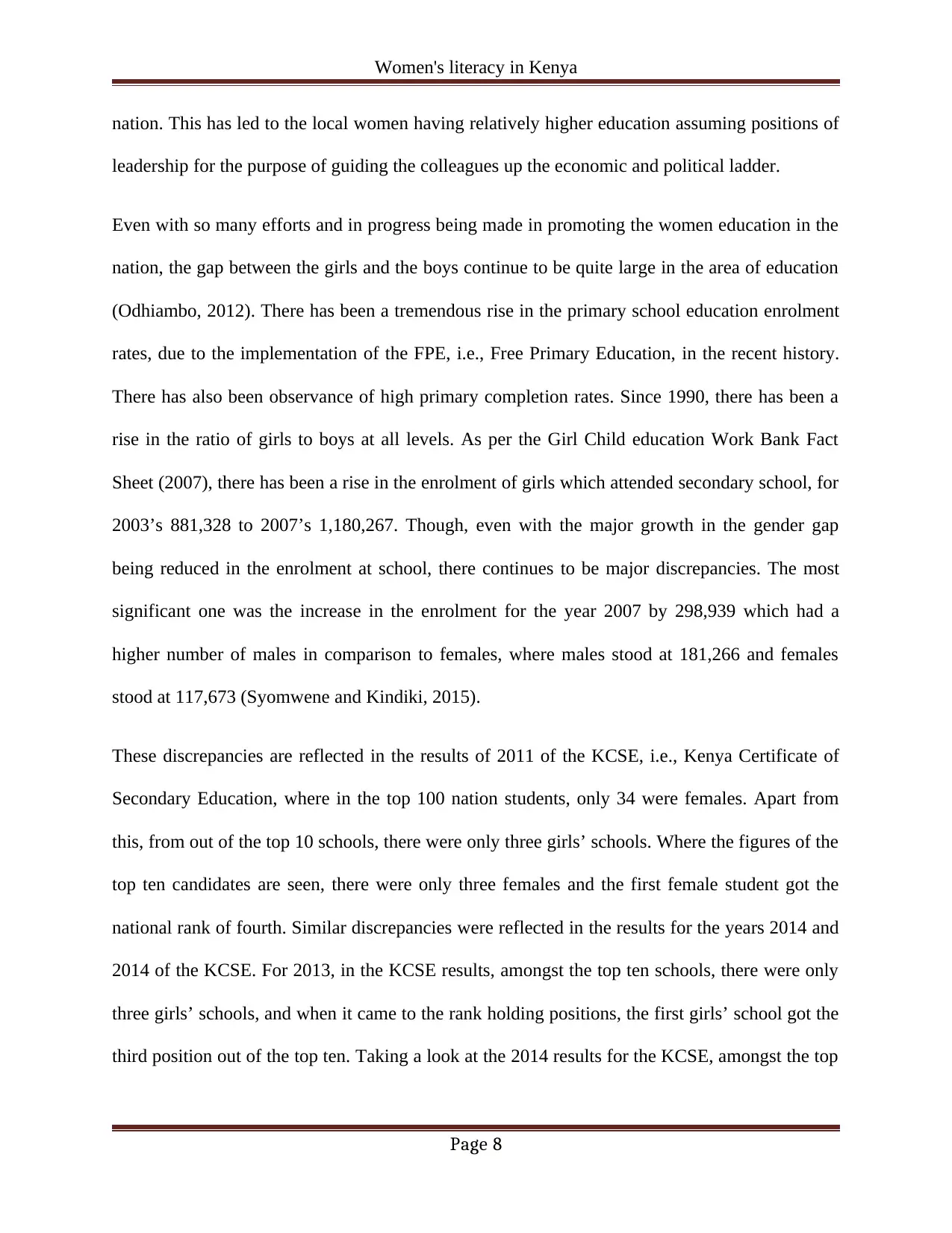
Women's literacy in Kenya
nation. This has led to the local women having relatively higher education assuming positions of
leadership for the purpose of guiding the colleagues up the economic and political ladder.
Even with so many efforts and in progress being made in promoting the women education in the
nation, the gap between the girls and the boys continue to be quite large in the area of education
(Odhiambo, 2012). There has been a tremendous rise in the primary school education enrolment
rates, due to the implementation of the FPE, i.e., Free Primary Education, in the recent history.
There has also been observance of high primary completion rates. Since 1990, there has been a
rise in the ratio of girls to boys at all levels. As per the Girl Child education Work Bank Fact
Sheet (2007), there has been a rise in the enrolment of girls which attended secondary school, for
2003’s 881,328 to 2007’s 1,180,267. Though, even with the major growth in the gender gap
being reduced in the enrolment at school, there continues to be major discrepancies. The most
significant one was the increase in the enrolment for the year 2007 by 298,939 which had a
higher number of males in comparison to females, where males stood at 181,266 and females
stood at 117,673 (Syomwene and Kindiki, 2015).
These discrepancies are reflected in the results of 2011 of the KCSE, i.e., Kenya Certificate of
Secondary Education, where in the top 100 nation students, only 34 were females. Apart from
this, from out of the top 10 schools, there were only three girls’ schools. Where the figures of the
top ten candidates are seen, there were only three females and the first female student got the
national rank of fourth. Similar discrepancies were reflected in the results for the years 2014 and
2014 of the KCSE. For 2013, in the KCSE results, amongst the top ten schools, there were only
three girls’ schools, and when it came to the rank holding positions, the first girls’ school got the
third position out of the top ten. Taking a look at the 2014 results for the KCSE, amongst the top
Page 8
nation. This has led to the local women having relatively higher education assuming positions of
leadership for the purpose of guiding the colleagues up the economic and political ladder.
Even with so many efforts and in progress being made in promoting the women education in the
nation, the gap between the girls and the boys continue to be quite large in the area of education
(Odhiambo, 2012). There has been a tremendous rise in the primary school education enrolment
rates, due to the implementation of the FPE, i.e., Free Primary Education, in the recent history.
There has also been observance of high primary completion rates. Since 1990, there has been a
rise in the ratio of girls to boys at all levels. As per the Girl Child education Work Bank Fact
Sheet (2007), there has been a rise in the enrolment of girls which attended secondary school, for
2003’s 881,328 to 2007’s 1,180,267. Though, even with the major growth in the gender gap
being reduced in the enrolment at school, there continues to be major discrepancies. The most
significant one was the increase in the enrolment for the year 2007 by 298,939 which had a
higher number of males in comparison to females, where males stood at 181,266 and females
stood at 117,673 (Syomwene and Kindiki, 2015).
These discrepancies are reflected in the results of 2011 of the KCSE, i.e., Kenya Certificate of
Secondary Education, where in the top 100 nation students, only 34 were females. Apart from
this, from out of the top 10 schools, there were only three girls’ schools. Where the figures of the
top ten candidates are seen, there were only three females and the first female student got the
national rank of fourth. Similar discrepancies were reflected in the results for the years 2014 and
2014 of the KCSE. For 2013, in the KCSE results, amongst the top ten schools, there were only
three girls’ schools, and when it came to the rank holding positions, the first girls’ school got the
third position out of the top ten. Taking a look at the 2014 results for the KCSE, amongst the top
Page 8

Women's literacy in Kenya
fifteen schools, there were only three girls’ schools and the first girls’ school was at the sixth
position (Syomwene and Kindiki, 2015).
It has been observed by the MoE (2007) that even with the FPE in motion in the nation, along
with the other interventions, there continues to be presence of gender disparities in achievement,
transition, access, performance, and retention at all education levels. This is particularly true in
context of the KCSE results presented here. Again, out of 100 girls in the nation, only 76 girls
complete their primary education in comparison to 87 boys as per Wamahiu (2011). With the
primary education not being completed, the secondary education becomes a distinct dream, along
with the drop outs from secondary education as well. This show that even with drop out being
common in both genders, the girls continue to be at a disadvantage. Due to such poor transitions,
there is a transition of gender imbalance at the higher education institutes. In particular, this is a
poor trend due to the education being a key determinant of the social mobility. When there is
gender disparity in the education, the women become ill prepared for competing in an equal
manner with their male counterparts, for the different jobs which need high level technological
skills, professionalism, and formal education (Chege and Sifuna, 2006). There are numerous
disparities despite a number of strategies being put in place to address the gender inequalities.
There is also the factor of lack of concern and the investment in girls’ education. There are a
lesser number of girls in comparison to boys’ at all educational systems due to the education of
boys being given more significance to that of girls. Families, which are not able to send both girl
and boy at school, send their sons at school and this is seen as a better deal. The idea of girl
leaving the parents home upon their marriage and being a financial liability is the reason behind
it. It is also postulated that women do not require education for empowering their living. There is
also a view that educated women cannot be easily controlled and are less feminine. There are
Page 9
fifteen schools, there were only three girls’ schools and the first girls’ school was at the sixth
position (Syomwene and Kindiki, 2015).
It has been observed by the MoE (2007) that even with the FPE in motion in the nation, along
with the other interventions, there continues to be presence of gender disparities in achievement,
transition, access, performance, and retention at all education levels. This is particularly true in
context of the KCSE results presented here. Again, out of 100 girls in the nation, only 76 girls
complete their primary education in comparison to 87 boys as per Wamahiu (2011). With the
primary education not being completed, the secondary education becomes a distinct dream, along
with the drop outs from secondary education as well. This show that even with drop out being
common in both genders, the girls continue to be at a disadvantage. Due to such poor transitions,
there is a transition of gender imbalance at the higher education institutes. In particular, this is a
poor trend due to the education being a key determinant of the social mobility. When there is
gender disparity in the education, the women become ill prepared for competing in an equal
manner with their male counterparts, for the different jobs which need high level technological
skills, professionalism, and formal education (Chege and Sifuna, 2006). There are numerous
disparities despite a number of strategies being put in place to address the gender inequalities.
There is also the factor of lack of concern and the investment in girls’ education. There are a
lesser number of girls in comparison to boys’ at all educational systems due to the education of
boys being given more significance to that of girls. Families, which are not able to send both girl
and boy at school, send their sons at school and this is seen as a better deal. The idea of girl
leaving the parents home upon their marriage and being a financial liability is the reason behind
it. It is also postulated that women do not require education for empowering their living. There is
also a view that educated women cannot be easily controlled and are less feminine. There are
Page 9
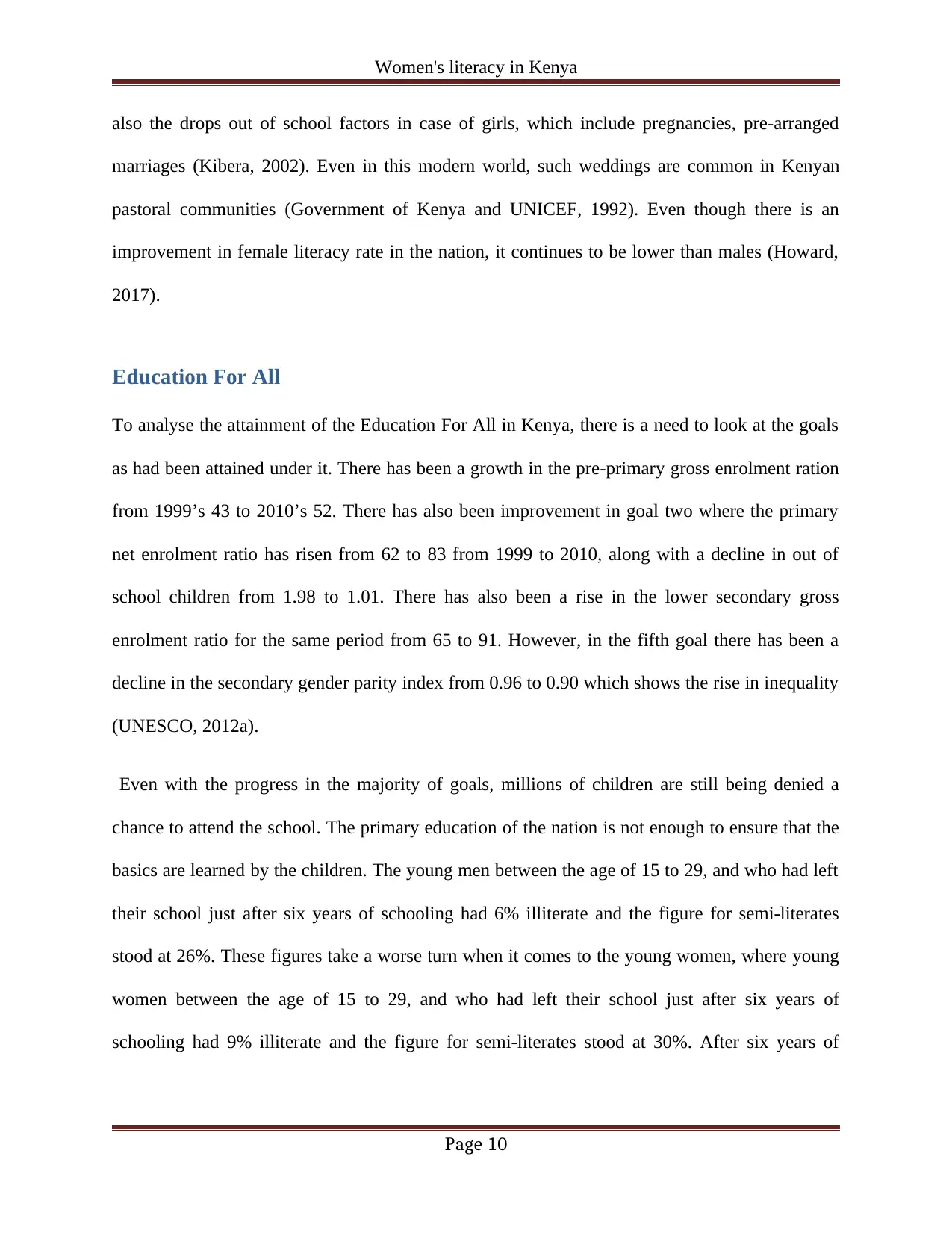
Women's literacy in Kenya
also the drops out of school factors in case of girls, which include pregnancies, pre-arranged
marriages (Kibera, 2002). Even in this modern world, such weddings are common in Kenyan
pastoral communities (Government of Kenya and UNICEF, 1992). Even though there is an
improvement in female literacy rate in the nation, it continues to be lower than males (Howard,
2017).
Education For All
To analyse the attainment of the Education For All in Kenya, there is a need to look at the goals
as had been attained under it. There has been a growth in the pre-primary gross enrolment ration
from 1999’s 43 to 2010’s 52. There has also been improvement in goal two where the primary
net enrolment ratio has risen from 62 to 83 from 1999 to 2010, along with a decline in out of
school children from 1.98 to 1.01. There has also been a rise in the lower secondary gross
enrolment ratio for the same period from 65 to 91. However, in the fifth goal there has been a
decline in the secondary gender parity index from 0.96 to 0.90 which shows the rise in inequality
(UNESCO, 2012a).
Even with the progress in the majority of goals, millions of children are still being denied a
chance to attend the school. The primary education of the nation is not enough to ensure that the
basics are learned by the children. The young men between the age of 15 to 29, and who had left
their school just after six years of schooling had 6% illiterate and the figure for semi-literates
stood at 26%. These figures take a worse turn when it comes to the young women, where young
women between the age of 15 to 29, and who had left their school just after six years of
schooling had 9% illiterate and the figure for semi-literates stood at 30%. After six years of
Page 10
also the drops out of school factors in case of girls, which include pregnancies, pre-arranged
marriages (Kibera, 2002). Even in this modern world, such weddings are common in Kenyan
pastoral communities (Government of Kenya and UNICEF, 1992). Even though there is an
improvement in female literacy rate in the nation, it continues to be lower than males (Howard,
2017).
Education For All
To analyse the attainment of the Education For All in Kenya, there is a need to look at the goals
as had been attained under it. There has been a growth in the pre-primary gross enrolment ration
from 1999’s 43 to 2010’s 52. There has also been improvement in goal two where the primary
net enrolment ratio has risen from 62 to 83 from 1999 to 2010, along with a decline in out of
school children from 1.98 to 1.01. There has also been a rise in the lower secondary gross
enrolment ratio for the same period from 65 to 91. However, in the fifth goal there has been a
decline in the secondary gender parity index from 0.96 to 0.90 which shows the rise in inequality
(UNESCO, 2012a).
Even with the progress in the majority of goals, millions of children are still being denied a
chance to attend the school. The primary education of the nation is not enough to ensure that the
basics are learned by the children. The young men between the age of 15 to 29, and who had left
their school just after six years of schooling had 6% illiterate and the figure for semi-literates
stood at 26%. These figures take a worse turn when it comes to the young women, where young
women between the age of 15 to 29, and who had left their school just after six years of
schooling had 9% illiterate and the figure for semi-literates stood at 30%. After six years of
Page 10
Secure Best Marks with AI Grader
Need help grading? Try our AI Grader for instant feedback on your assignments.
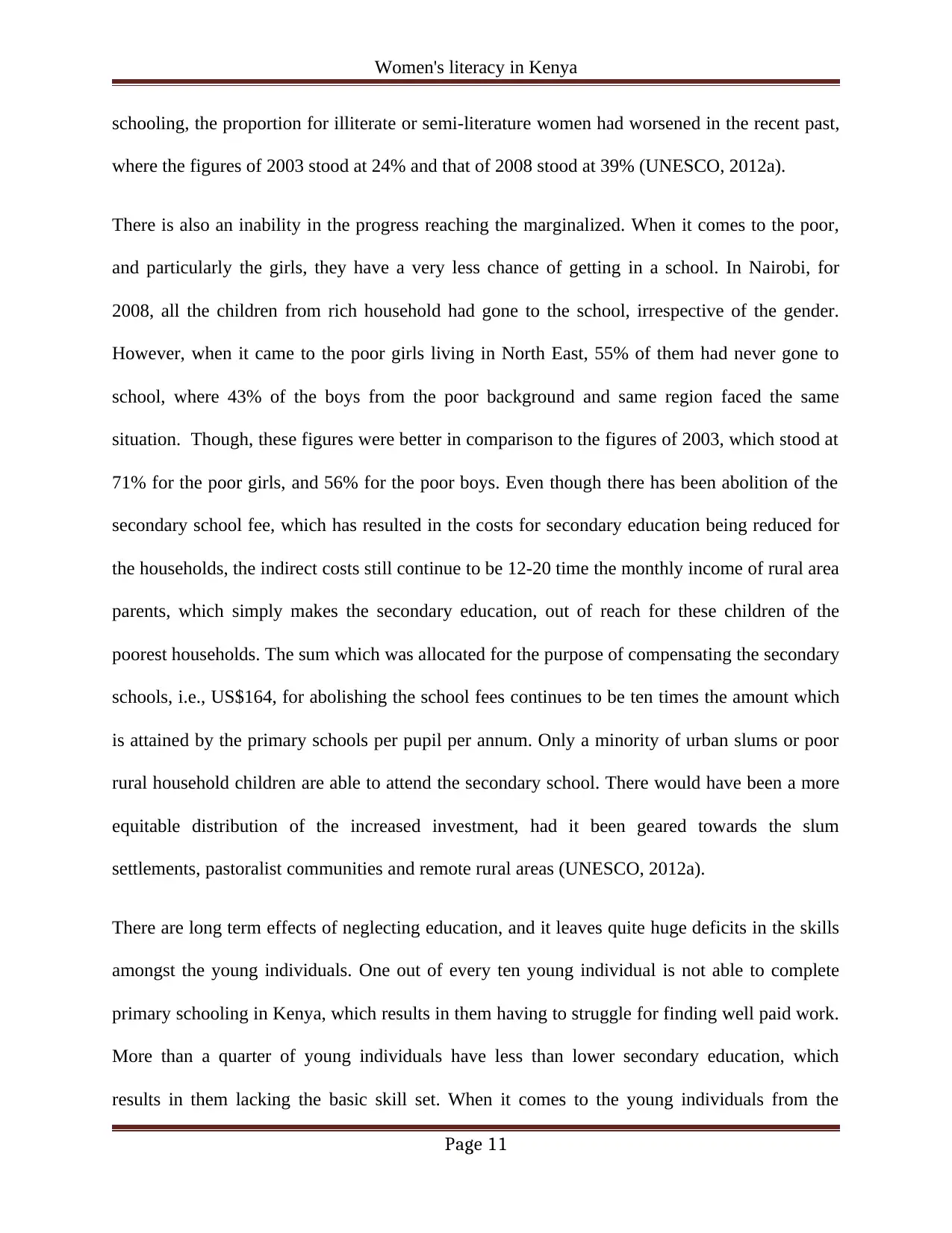
Women's literacy in Kenya
schooling, the proportion for illiterate or semi-literature women had worsened in the recent past,
where the figures of 2003 stood at 24% and that of 2008 stood at 39% (UNESCO, 2012a).
There is also an inability in the progress reaching the marginalized. When it comes to the poor,
and particularly the girls, they have a very less chance of getting in a school. In Nairobi, for
2008, all the children from rich household had gone to the school, irrespective of the gender.
However, when it came to the poor girls living in North East, 55% of them had never gone to
school, where 43% of the boys from the poor background and same region faced the same
situation. Though, these figures were better in comparison to the figures of 2003, which stood at
71% for the poor girls, and 56% for the poor boys. Even though there has been abolition of the
secondary school fee, which has resulted in the costs for secondary education being reduced for
the households, the indirect costs still continue to be 12-20 time the monthly income of rural area
parents, which simply makes the secondary education, out of reach for these children of the
poorest households. The sum which was allocated for the purpose of compensating the secondary
schools, i.e., US$164, for abolishing the school fees continues to be ten times the amount which
is attained by the primary schools per pupil per annum. Only a minority of urban slums or poor
rural household children are able to attend the secondary school. There would have been a more
equitable distribution of the increased investment, had it been geared towards the slum
settlements, pastoralist communities and remote rural areas (UNESCO, 2012a).
There are long term effects of neglecting education, and it leaves quite huge deficits in the skills
amongst the young individuals. One out of every ten young individual is not able to complete
primary schooling in Kenya, which results in them having to struggle for finding well paid work.
More than a quarter of young individuals have less than lower secondary education, which
results in them lacking the basic skill set. When it comes to the young individuals from the
Page 11
schooling, the proportion for illiterate or semi-literature women had worsened in the recent past,
where the figures of 2003 stood at 24% and that of 2008 stood at 39% (UNESCO, 2012a).
There is also an inability in the progress reaching the marginalized. When it comes to the poor,
and particularly the girls, they have a very less chance of getting in a school. In Nairobi, for
2008, all the children from rich household had gone to the school, irrespective of the gender.
However, when it came to the poor girls living in North East, 55% of them had never gone to
school, where 43% of the boys from the poor background and same region faced the same
situation. Though, these figures were better in comparison to the figures of 2003, which stood at
71% for the poor girls, and 56% for the poor boys. Even though there has been abolition of the
secondary school fee, which has resulted in the costs for secondary education being reduced for
the households, the indirect costs still continue to be 12-20 time the monthly income of rural area
parents, which simply makes the secondary education, out of reach for these children of the
poorest households. The sum which was allocated for the purpose of compensating the secondary
schools, i.e., US$164, for abolishing the school fees continues to be ten times the amount which
is attained by the primary schools per pupil per annum. Only a minority of urban slums or poor
rural household children are able to attend the secondary school. There would have been a more
equitable distribution of the increased investment, had it been geared towards the slum
settlements, pastoralist communities and remote rural areas (UNESCO, 2012a).
There are long term effects of neglecting education, and it leaves quite huge deficits in the skills
amongst the young individuals. One out of every ten young individual is not able to complete
primary schooling in Kenya, which results in them having to struggle for finding well paid work.
More than a quarter of young individuals have less than lower secondary education, which
results in them lacking the basic skill set. When it comes to the young individuals from the
Page 11

Women's literacy in Kenya
disadvantaged backgrounds, they have less chances of getting decent work. The figures of lower
secondary education is a proof of it, where 27% men have less than lower secondary education
and this figure for women stands at 32%, again highlighting the gender disparity in education.
Out of the three million inhabitants of Nairobi, 60% live in slums. Young people make up 1/3rd
of the population of Korogocho and Viwandani, which are the two poorest slums. As there is no
secondary education in such slums, only 19% males and 12% females in Korogocho attended
secondary school. One in five between the ages of 19-20 held the skill or training and only half
of these could make use of their trainings for the purpose of earning income. As a result of the
lack of skills, the young individuals are forever affected. This is because between the ages of 15
to 24, 50% males and 80% females had no activities to generate income. The ones who are
employed have casual employment earning, which is around poverty line for 60% men and 40%
women (UNESCO, 2012a).
Factors causing hurdle in gender equality
As discussed in the introduction segment, there are a number of challenges being faced by Kenya
in attaining the goals of education for all. The first one in this regard is the gender disparity. The
girl child in the nation still continues to be in a vulnerable state. The cultural norms, the parental
gender bias, the poverty and the negative impact of the pandemic of HIV/AIDS have an adverse
impact over the participation of girl child in education. There has been constant progress in the
gender party which shows that the gender differences could be given away with change in
attitude and public policy. However, there is a long way to go for this as only fifty nine nations
have been able to attain gender equality in secondary and primary education. When it comes to
the gender equality in the outcomes and the education opportunities, it becomes the most
challenge task to attain, and is more difficult for measuring. There is a still a lot that needs to be
Page 12
disadvantaged backgrounds, they have less chances of getting decent work. The figures of lower
secondary education is a proof of it, where 27% men have less than lower secondary education
and this figure for women stands at 32%, again highlighting the gender disparity in education.
Out of the three million inhabitants of Nairobi, 60% live in slums. Young people make up 1/3rd
of the population of Korogocho and Viwandani, which are the two poorest slums. As there is no
secondary education in such slums, only 19% males and 12% females in Korogocho attended
secondary school. One in five between the ages of 19-20 held the skill or training and only half
of these could make use of their trainings for the purpose of earning income. As a result of the
lack of skills, the young individuals are forever affected. This is because between the ages of 15
to 24, 50% males and 80% females had no activities to generate income. The ones who are
employed have casual employment earning, which is around poverty line for 60% men and 40%
women (UNESCO, 2012a).
Factors causing hurdle in gender equality
As discussed in the introduction segment, there are a number of challenges being faced by Kenya
in attaining the goals of education for all. The first one in this regard is the gender disparity. The
girl child in the nation still continues to be in a vulnerable state. The cultural norms, the parental
gender bias, the poverty and the negative impact of the pandemic of HIV/AIDS have an adverse
impact over the participation of girl child in education. There has been constant progress in the
gender party which shows that the gender differences could be given away with change in
attitude and public policy. However, there is a long way to go for this as only fifty nine nations
have been able to attain gender equality in secondary and primary education. When it comes to
the gender equality in the outcomes and the education opportunities, it becomes the most
challenge task to attain, and is more difficult for measuring. There is a still a lot that needs to be
Page 12
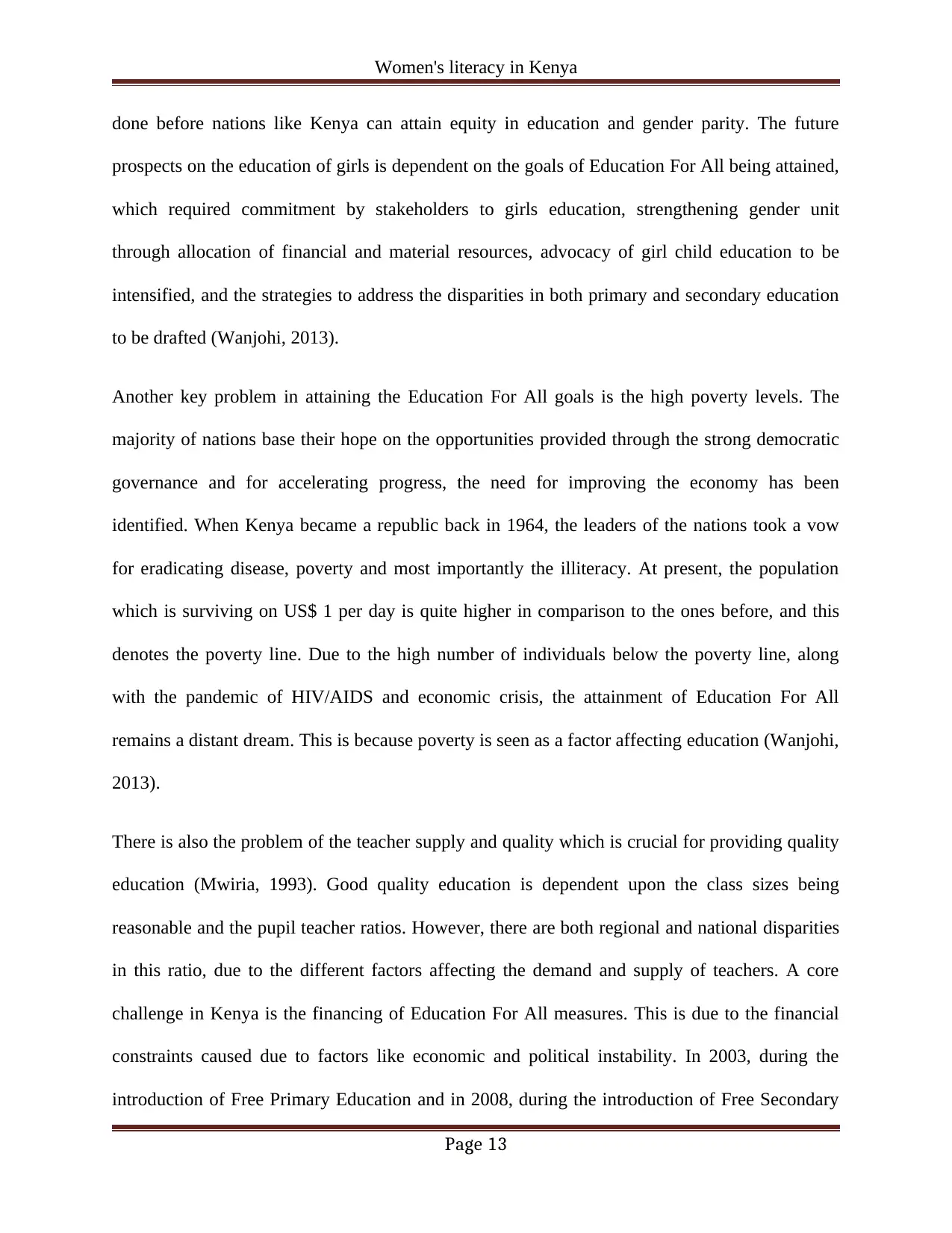
Women's literacy in Kenya
done before nations like Kenya can attain equity in education and gender parity. The future
prospects on the education of girls is dependent on the goals of Education For All being attained,
which required commitment by stakeholders to girls education, strengthening gender unit
through allocation of financial and material resources, advocacy of girl child education to be
intensified, and the strategies to address the disparities in both primary and secondary education
to be drafted (Wanjohi, 2013).
Another key problem in attaining the Education For All goals is the high poverty levels. The
majority of nations base their hope on the opportunities provided through the strong democratic
governance and for accelerating progress, the need for improving the economy has been
identified. When Kenya became a republic back in 1964, the leaders of the nations took a vow
for eradicating disease, poverty and most importantly the illiteracy. At present, the population
which is surviving on US$ 1 per day is quite higher in comparison to the ones before, and this
denotes the poverty line. Due to the high number of individuals below the poverty line, along
with the pandemic of HIV/AIDS and economic crisis, the attainment of Education For All
remains a distant dream. This is because poverty is seen as a factor affecting education (Wanjohi,
2013).
There is also the problem of the teacher supply and quality which is crucial for providing quality
education (Mwiria, 1993). Good quality education is dependent upon the class sizes being
reasonable and the pupil teacher ratios. However, there are both regional and national disparities
in this ratio, due to the different factors affecting the demand and supply of teachers. A core
challenge in Kenya is the financing of Education For All measures. This is due to the financial
constraints caused due to factors like economic and political instability. In 2003, during the
introduction of Free Primary Education and in 2008, during the introduction of Free Secondary
Page 13
done before nations like Kenya can attain equity in education and gender parity. The future
prospects on the education of girls is dependent on the goals of Education For All being attained,
which required commitment by stakeholders to girls education, strengthening gender unit
through allocation of financial and material resources, advocacy of girl child education to be
intensified, and the strategies to address the disparities in both primary and secondary education
to be drafted (Wanjohi, 2013).
Another key problem in attaining the Education For All goals is the high poverty levels. The
majority of nations base their hope on the opportunities provided through the strong democratic
governance and for accelerating progress, the need for improving the economy has been
identified. When Kenya became a republic back in 1964, the leaders of the nations took a vow
for eradicating disease, poverty and most importantly the illiteracy. At present, the population
which is surviving on US$ 1 per day is quite higher in comparison to the ones before, and this
denotes the poverty line. Due to the high number of individuals below the poverty line, along
with the pandemic of HIV/AIDS and economic crisis, the attainment of Education For All
remains a distant dream. This is because poverty is seen as a factor affecting education (Wanjohi,
2013).
There is also the problem of the teacher supply and quality which is crucial for providing quality
education (Mwiria, 1993). Good quality education is dependent upon the class sizes being
reasonable and the pupil teacher ratios. However, there are both regional and national disparities
in this ratio, due to the different factors affecting the demand and supply of teachers. A core
challenge in Kenya is the financing of Education For All measures. This is due to the financial
constraints caused due to factors like economic and political instability. In 2003, during the
introduction of Free Primary Education and in 2008, during the introduction of Free Secondary
Page 13
Paraphrase This Document
Need a fresh take? Get an instant paraphrase of this document with our AI Paraphraser
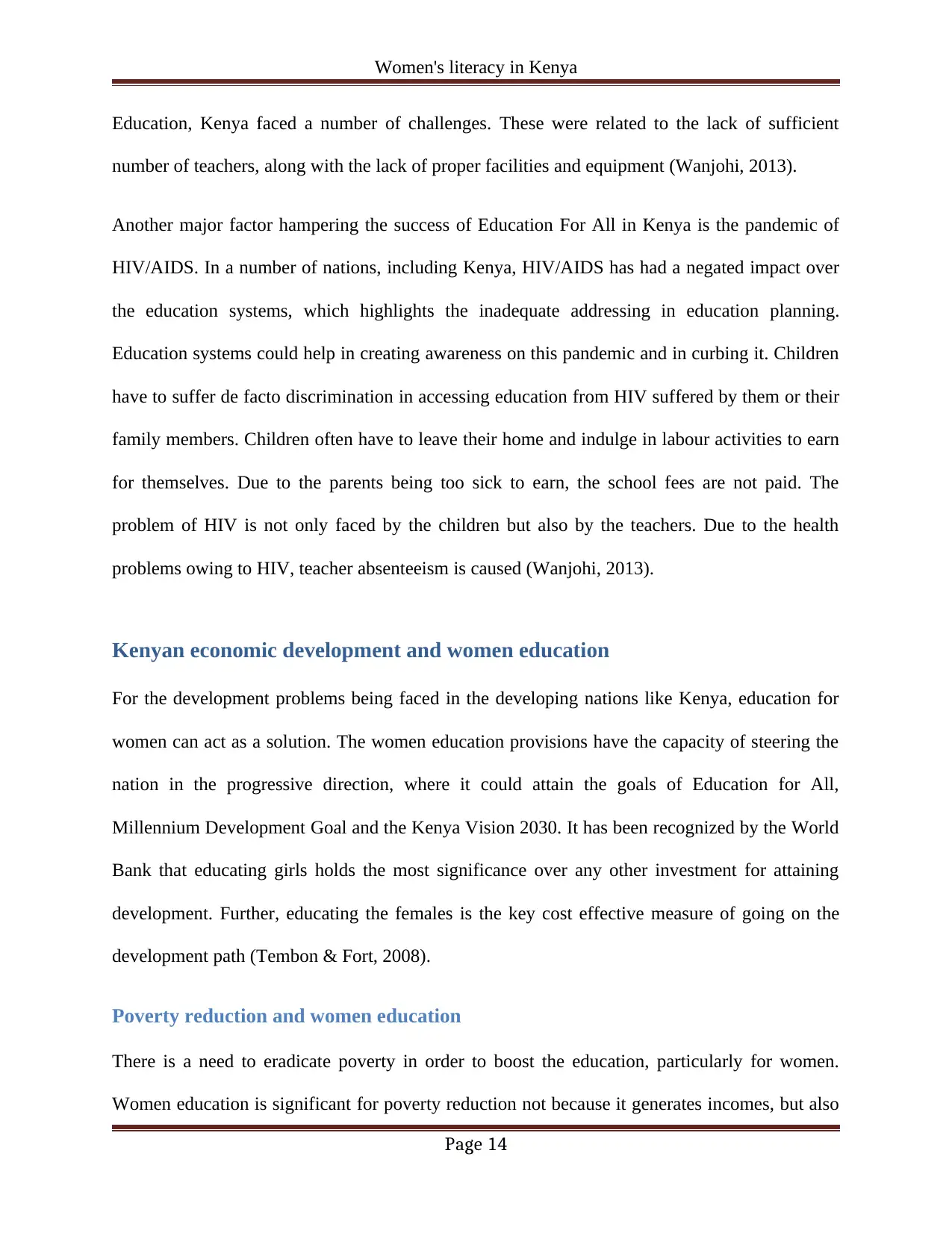
Women's literacy in Kenya
Education, Kenya faced a number of challenges. These were related to the lack of sufficient
number of teachers, along with the lack of proper facilities and equipment (Wanjohi, 2013).
Another major factor hampering the success of Education For All in Kenya is the pandemic of
HIV/AIDS. In a number of nations, including Kenya, HIV/AIDS has had a negated impact over
the education systems, which highlights the inadequate addressing in education planning.
Education systems could help in creating awareness on this pandemic and in curbing it. Children
have to suffer de facto discrimination in accessing education from HIV suffered by them or their
family members. Children often have to leave their home and indulge in labour activities to earn
for themselves. Due to the parents being too sick to earn, the school fees are not paid. The
problem of HIV is not only faced by the children but also by the teachers. Due to the health
problems owing to HIV, teacher absenteeism is caused (Wanjohi, 2013).
Kenyan economic development and women education
For the development problems being faced in the developing nations like Kenya, education for
women can act as a solution. The women education provisions have the capacity of steering the
nation in the progressive direction, where it could attain the goals of Education for All,
Millennium Development Goal and the Kenya Vision 2030. It has been recognized by the World
Bank that educating girls holds the most significance over any other investment for attaining
development. Further, educating the females is the key cost effective measure of going on the
development path (Tembon & Fort, 2008).
Poverty reduction and women education
There is a need to eradicate poverty in order to boost the education, particularly for women.
Women education is significant for poverty reduction not because it generates incomes, but also
Page 14
Education, Kenya faced a number of challenges. These were related to the lack of sufficient
number of teachers, along with the lack of proper facilities and equipment (Wanjohi, 2013).
Another major factor hampering the success of Education For All in Kenya is the pandemic of
HIV/AIDS. In a number of nations, including Kenya, HIV/AIDS has had a negated impact over
the education systems, which highlights the inadequate addressing in education planning.
Education systems could help in creating awareness on this pandemic and in curbing it. Children
have to suffer de facto discrimination in accessing education from HIV suffered by them or their
family members. Children often have to leave their home and indulge in labour activities to earn
for themselves. Due to the parents being too sick to earn, the school fees are not paid. The
problem of HIV is not only faced by the children but also by the teachers. Due to the health
problems owing to HIV, teacher absenteeism is caused (Wanjohi, 2013).
Kenyan economic development and women education
For the development problems being faced in the developing nations like Kenya, education for
women can act as a solution. The women education provisions have the capacity of steering the
nation in the progressive direction, where it could attain the goals of Education for All,
Millennium Development Goal and the Kenya Vision 2030. It has been recognized by the World
Bank that educating girls holds the most significance over any other investment for attaining
development. Further, educating the females is the key cost effective measure of going on the
development path (Tembon & Fort, 2008).
Poverty reduction and women education
There is a need to eradicate poverty in order to boost the education, particularly for women.
Women education is significant for poverty reduction not because it generates incomes, but also
Page 14
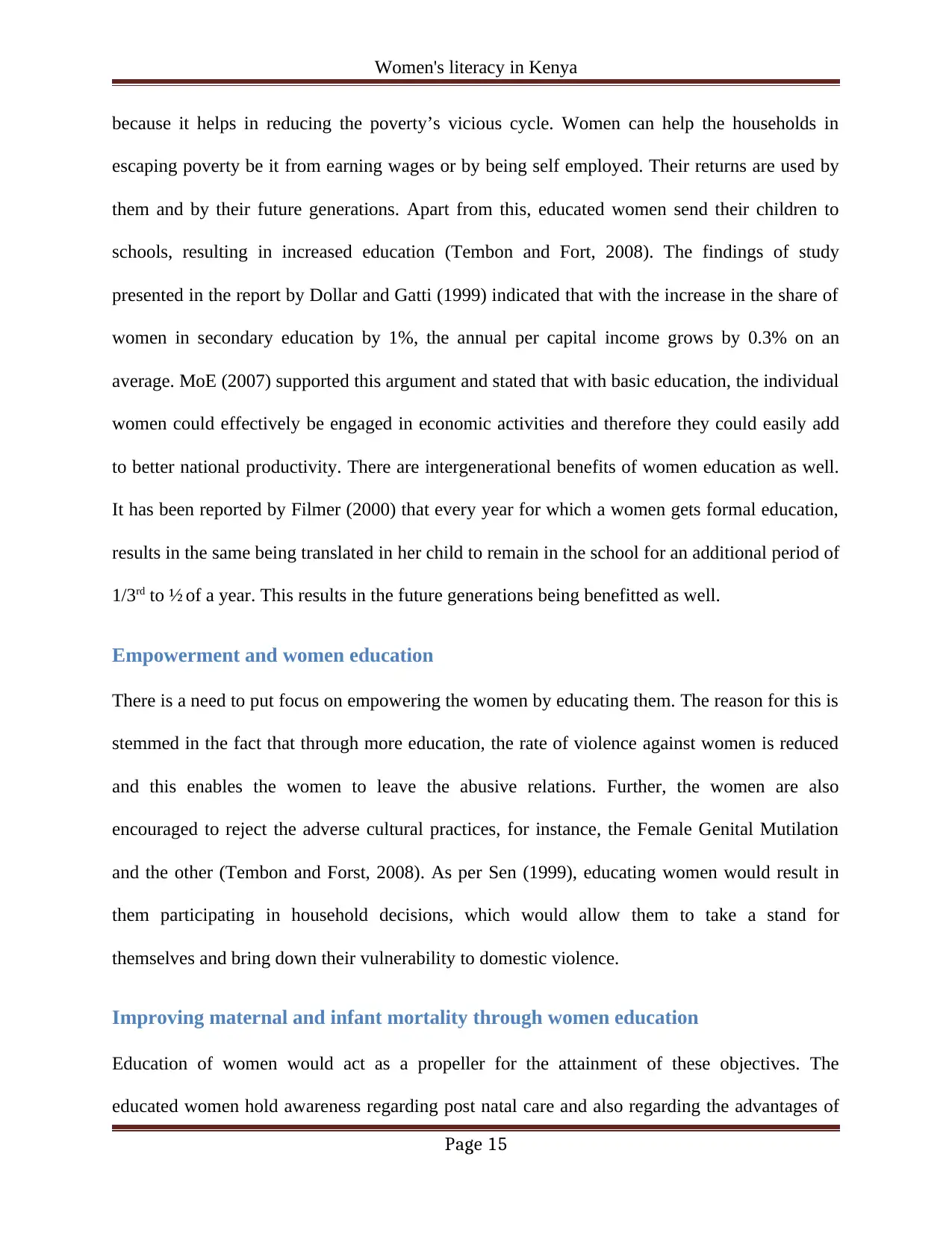
Women's literacy in Kenya
because it helps in reducing the poverty’s vicious cycle. Women can help the households in
escaping poverty be it from earning wages or by being self employed. Their returns are used by
them and by their future generations. Apart from this, educated women send their children to
schools, resulting in increased education (Tembon and Fort, 2008). The findings of study
presented in the report by Dollar and Gatti (1999) indicated that with the increase in the share of
women in secondary education by 1%, the annual per capital income grows by 0.3% on an
average. MoE (2007) supported this argument and stated that with basic education, the individual
women could effectively be engaged in economic activities and therefore they could easily add
to better national productivity. There are intergenerational benefits of women education as well.
It has been reported by Filmer (2000) that every year for which a women gets formal education,
results in the same being translated in her child to remain in the school for an additional period of
1/3rd to ½ of a year. This results in the future generations being benefitted as well.
Empowerment and women education
There is a need to put focus on empowering the women by educating them. The reason for this is
stemmed in the fact that through more education, the rate of violence against women is reduced
and this enables the women to leave the abusive relations. Further, the women are also
encouraged to reject the adverse cultural practices, for instance, the Female Genital Mutilation
and the other (Tembon and Forst, 2008). As per Sen (1999), educating women would result in
them participating in household decisions, which would allow them to take a stand for
themselves and bring down their vulnerability to domestic violence.
Improving maternal and infant mortality through women education
Education of women would act as a propeller for the attainment of these objectives. The
educated women hold awareness regarding post natal care and also regarding the advantages of
Page 15
because it helps in reducing the poverty’s vicious cycle. Women can help the households in
escaping poverty be it from earning wages or by being self employed. Their returns are used by
them and by their future generations. Apart from this, educated women send their children to
schools, resulting in increased education (Tembon and Fort, 2008). The findings of study
presented in the report by Dollar and Gatti (1999) indicated that with the increase in the share of
women in secondary education by 1%, the annual per capital income grows by 0.3% on an
average. MoE (2007) supported this argument and stated that with basic education, the individual
women could effectively be engaged in economic activities and therefore they could easily add
to better national productivity. There are intergenerational benefits of women education as well.
It has been reported by Filmer (2000) that every year for which a women gets formal education,
results in the same being translated in her child to remain in the school for an additional period of
1/3rd to ½ of a year. This results in the future generations being benefitted as well.
Empowerment and women education
There is a need to put focus on empowering the women by educating them. The reason for this is
stemmed in the fact that through more education, the rate of violence against women is reduced
and this enables the women to leave the abusive relations. Further, the women are also
encouraged to reject the adverse cultural practices, for instance, the Female Genital Mutilation
and the other (Tembon and Forst, 2008). As per Sen (1999), educating women would result in
them participating in household decisions, which would allow them to take a stand for
themselves and bring down their vulnerability to domestic violence.
Improving maternal and infant mortality through women education
Education of women would act as a propeller for the attainment of these objectives. The
educated women hold awareness regarding post natal care and also regarding the advantages of
Page 15

Women's literacy in Kenya
breast feeding. The children of educated women are provided balanced diet (Chen and Li, 2009).
As per Schultz (1993), female schooling’s addition year resulted in reducing the child mortality
being reduced by 5-10%. UNICEF (2003) established that an additional year in school resulted
in a thousand women being helped in preventing maternal deaths. MoE (2007) provides that
educated women could bring up better educated families and children and healthier ones as well,
bringing down the maternal and infant mortality rates.
Improving family health through women education
A key problem in attaining Education For All is the pandemic of HIV/AIDS. Through women
education, this issue can be resolved. This is because education of girls is deemed as the most
cost effective way of improving the well-being and the health of family in nations like Kenya,
and the education of males is not likely to have the same effect. The women who are educated
hold the skills and the knowledge for giving proper diet to their families. The educated women
attend prenatal care which helps in improving the wellbeing and health of the expectants. This is
due to t eh fact that most of them can earn for themselves and can make payment for the prenatal
care services along with the other requirements. Through education of women, the health of
children is improved owing to the greater knowledge of mothers regarding hygiene being
important (King and Hill, 1993).
The nations which have a higher level of female secondary education enrolment hold low infant
mortality rate, better child nutrition and low rates of HIV/AIDS (Tembon and Forst, 2008).
Education is basically the vaccine of AIDS as due to increase in education, the infections of
HIV/AIDS decrease. As per the study conducted by De Walque (2004), the Ugandan women
having secondary education had 3 times less chance of being HIV positive in comparison to the
ones who had no education. Educated women have less vulnerability to AIDS/HIV and can also
Page 16
breast feeding. The children of educated women are provided balanced diet (Chen and Li, 2009).
As per Schultz (1993), female schooling’s addition year resulted in reducing the child mortality
being reduced by 5-10%. UNICEF (2003) established that an additional year in school resulted
in a thousand women being helped in preventing maternal deaths. MoE (2007) provides that
educated women could bring up better educated families and children and healthier ones as well,
bringing down the maternal and infant mortality rates.
Improving family health through women education
A key problem in attaining Education For All is the pandemic of HIV/AIDS. Through women
education, this issue can be resolved. This is because education of girls is deemed as the most
cost effective way of improving the well-being and the health of family in nations like Kenya,
and the education of males is not likely to have the same effect. The women who are educated
hold the skills and the knowledge for giving proper diet to their families. The educated women
attend prenatal care which helps in improving the wellbeing and health of the expectants. This is
due to t eh fact that most of them can earn for themselves and can make payment for the prenatal
care services along with the other requirements. Through education of women, the health of
children is improved owing to the greater knowledge of mothers regarding hygiene being
important (King and Hill, 1993).
The nations which have a higher level of female secondary education enrolment hold low infant
mortality rate, better child nutrition and low rates of HIV/AIDS (Tembon and Forst, 2008).
Education is basically the vaccine of AIDS as due to increase in education, the infections of
HIV/AIDS decrease. As per the study conducted by De Walque (2004), the Ugandan women
having secondary education had 3 times less chance of being HIV positive in comparison to the
ones who had no education. Educated women have less vulnerability to AIDS/HIV and can also
Page 16
Secure Best Marks with AI Grader
Need help grading? Try our AI Grader for instant feedback on your assignments.
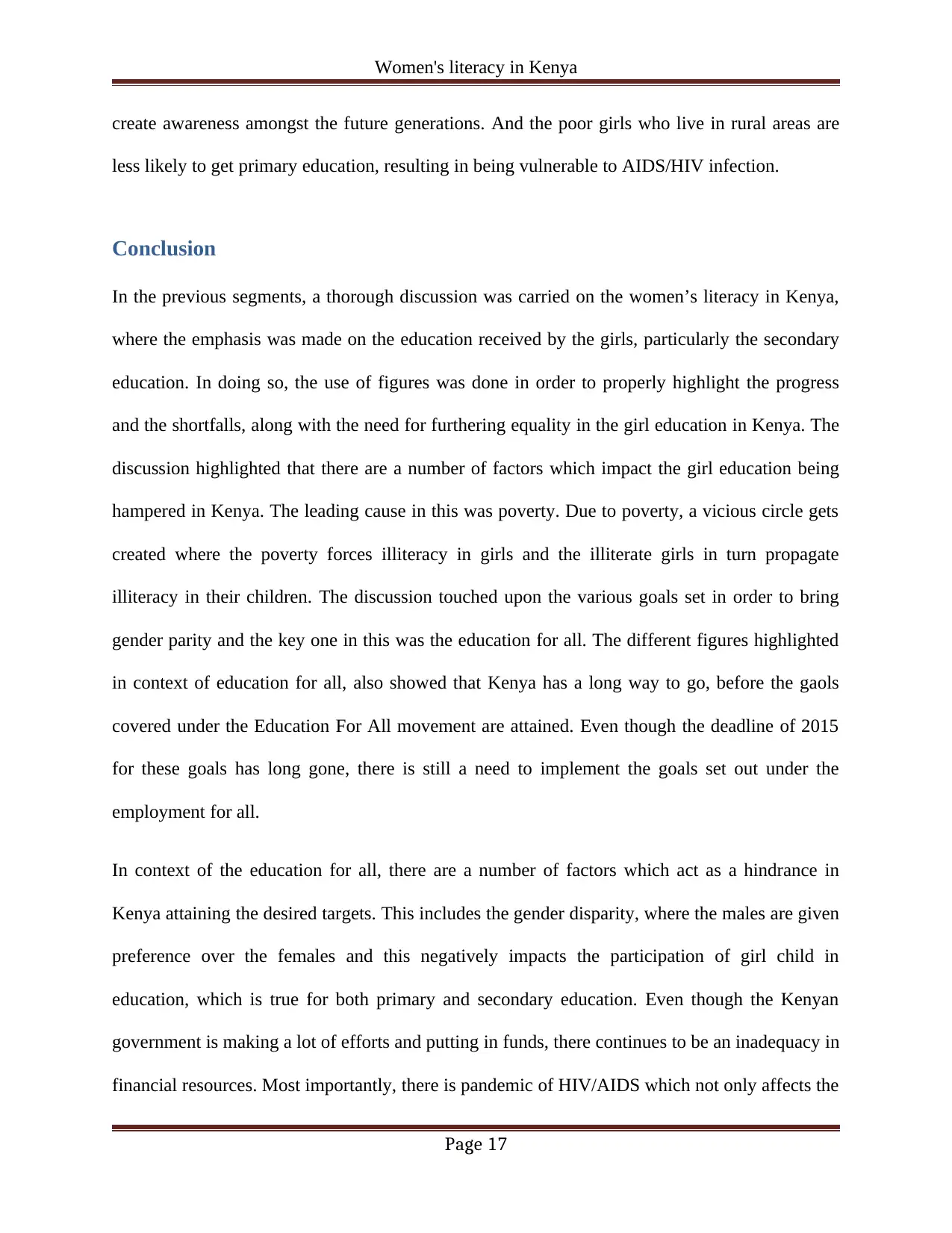
Women's literacy in Kenya
create awareness amongst the future generations. And the poor girls who live in rural areas are
less likely to get primary education, resulting in being vulnerable to AIDS/HIV infection.
Conclusion
In the previous segments, a thorough discussion was carried on the women’s literacy in Kenya,
where the emphasis was made on the education received by the girls, particularly the secondary
education. In doing so, the use of figures was done in order to properly highlight the progress
and the shortfalls, along with the need for furthering equality in the girl education in Kenya. The
discussion highlighted that there are a number of factors which impact the girl education being
hampered in Kenya. The leading cause in this was poverty. Due to poverty, a vicious circle gets
created where the poverty forces illiteracy in girls and the illiterate girls in turn propagate
illiteracy in their children. The discussion touched upon the various goals set in order to bring
gender parity and the key one in this was the education for all. The different figures highlighted
in context of education for all, also showed that Kenya has a long way to go, before the gaols
covered under the Education For All movement are attained. Even though the deadline of 2015
for these goals has long gone, there is still a need to implement the goals set out under the
employment for all.
In context of the education for all, there are a number of factors which act as a hindrance in
Kenya attaining the desired targets. This includes the gender disparity, where the males are given
preference over the females and this negatively impacts the participation of girl child in
education, which is true for both primary and secondary education. Even though the Kenyan
government is making a lot of efforts and putting in funds, there continues to be an inadequacy in
financial resources. Most importantly, there is pandemic of HIV/AIDS which not only affects the
Page 17
create awareness amongst the future generations. And the poor girls who live in rural areas are
less likely to get primary education, resulting in being vulnerable to AIDS/HIV infection.
Conclusion
In the previous segments, a thorough discussion was carried on the women’s literacy in Kenya,
where the emphasis was made on the education received by the girls, particularly the secondary
education. In doing so, the use of figures was done in order to properly highlight the progress
and the shortfalls, along with the need for furthering equality in the girl education in Kenya. The
discussion highlighted that there are a number of factors which impact the girl education being
hampered in Kenya. The leading cause in this was poverty. Due to poverty, a vicious circle gets
created where the poverty forces illiteracy in girls and the illiterate girls in turn propagate
illiteracy in their children. The discussion touched upon the various goals set in order to bring
gender parity and the key one in this was the education for all. The different figures highlighted
in context of education for all, also showed that Kenya has a long way to go, before the gaols
covered under the Education For All movement are attained. Even though the deadline of 2015
for these goals has long gone, there is still a need to implement the goals set out under the
employment for all.
In context of the education for all, there are a number of factors which act as a hindrance in
Kenya attaining the desired targets. This includes the gender disparity, where the males are given
preference over the females and this negatively impacts the participation of girl child in
education, which is true for both primary and secondary education. Even though the Kenyan
government is making a lot of efforts and putting in funds, there continues to be an inadequacy in
financial resources. Most importantly, there is pandemic of HIV/AIDS which not only affects the
Page 17
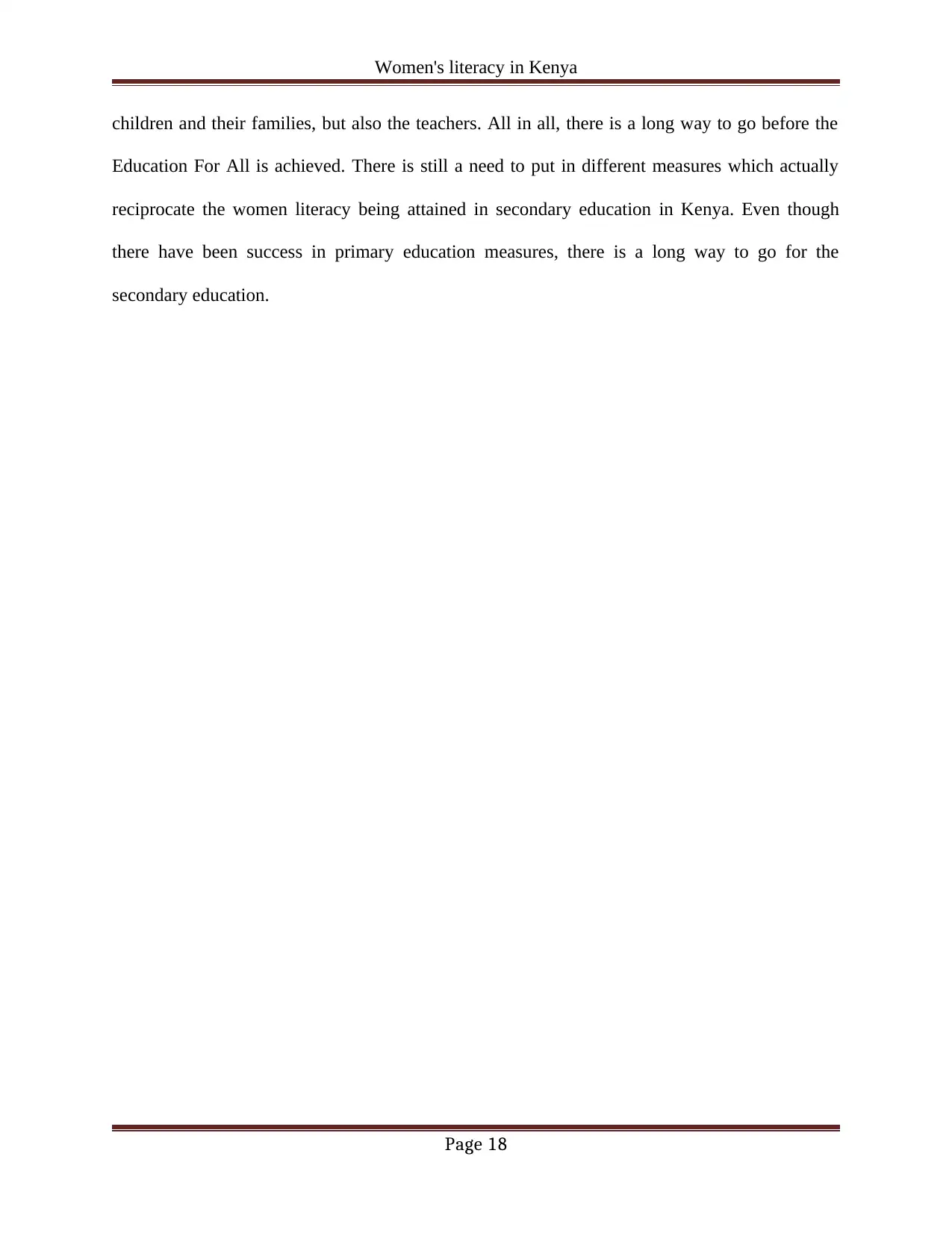
Women's literacy in Kenya
children and their families, but also the teachers. All in all, there is a long way to go before the
Education For All is achieved. There is still a need to put in different measures which actually
reciprocate the women literacy being attained in secondary education in Kenya. Even though
there have been success in primary education measures, there is a long way to go for the
secondary education.
Page 18
children and their families, but also the teachers. All in all, there is a long way to go before the
Education For All is achieved. There is still a need to put in different measures which actually
reciprocate the women literacy being attained in secondary education in Kenya. Even though
there have been success in primary education measures, there is a long way to go for the
secondary education.
Page 18
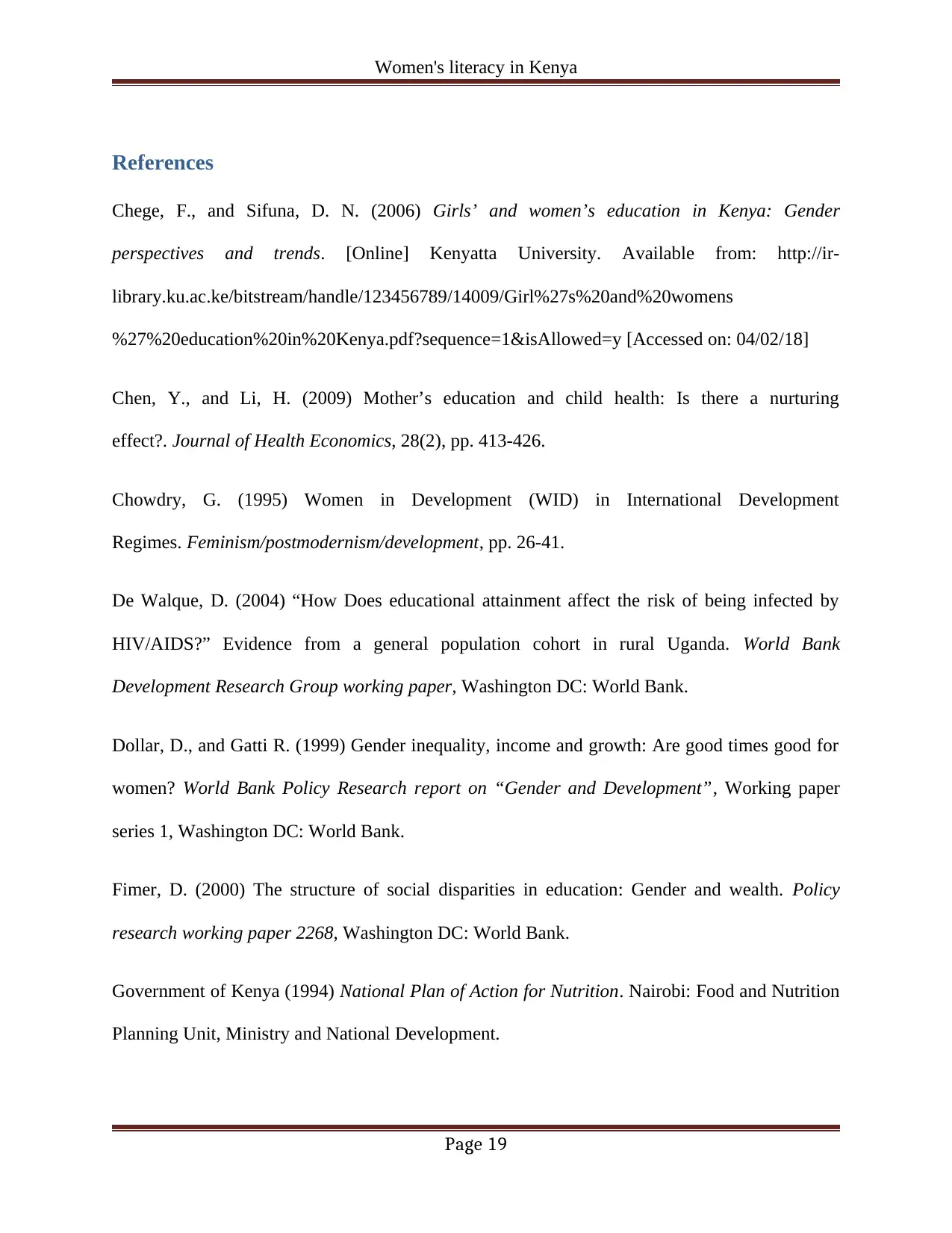
Women's literacy in Kenya
References
Chege, F., and Sifuna, D. N. (2006) Girls’ and women’s education in Kenya: Gender
perspectives and trends. [Online] Kenyatta University. Available from: http://ir-
library.ku.ac.ke/bitstream/handle/123456789/14009/Girl%27s%20and%20womens
%27%20education%20in%20Kenya.pdf?sequence=1&isAllowed=y [Accessed on: 04/02/18]
Chen, Y., and Li, H. (2009) Mother’s education and child health: Is there a nurturing
effect?. Journal of Health Economics, 28(2), pp. 413-426.
Chowdry, G. (1995) Women in Development (WID) in International Development
Regimes. Feminism/postmodernism/development, pp. 26-41.
De Walque, D. (2004) “How Does educational attainment affect the risk of being infected by
HIV/AIDS?” Evidence from a general population cohort in rural Uganda. World Bank
Development Research Group working paper, Washington DC: World Bank.
Dollar, D., and Gatti R. (1999) Gender inequality, income and growth: Are good times good for
women? World Bank Policy Research report on “Gender and Development”, Working paper
series 1, Washington DC: World Bank.
Fimer, D. (2000) The structure of social disparities in education: Gender and wealth. Policy
research working paper 2268, Washington DC: World Bank.
Government of Kenya (1994) National Plan of Action for Nutrition. Nairobi: Food and Nutrition
Planning Unit, Ministry and National Development.
Page 19
References
Chege, F., and Sifuna, D. N. (2006) Girls’ and women’s education in Kenya: Gender
perspectives and trends. [Online] Kenyatta University. Available from: http://ir-
library.ku.ac.ke/bitstream/handle/123456789/14009/Girl%27s%20and%20womens
%27%20education%20in%20Kenya.pdf?sequence=1&isAllowed=y [Accessed on: 04/02/18]
Chen, Y., and Li, H. (2009) Mother’s education and child health: Is there a nurturing
effect?. Journal of Health Economics, 28(2), pp. 413-426.
Chowdry, G. (1995) Women in Development (WID) in International Development
Regimes. Feminism/postmodernism/development, pp. 26-41.
De Walque, D. (2004) “How Does educational attainment affect the risk of being infected by
HIV/AIDS?” Evidence from a general population cohort in rural Uganda. World Bank
Development Research Group working paper, Washington DC: World Bank.
Dollar, D., and Gatti R. (1999) Gender inequality, income and growth: Are good times good for
women? World Bank Policy Research report on “Gender and Development”, Working paper
series 1, Washington DC: World Bank.
Fimer, D. (2000) The structure of social disparities in education: Gender and wealth. Policy
research working paper 2268, Washington DC: World Bank.
Government of Kenya (1994) National Plan of Action for Nutrition. Nairobi: Food and Nutrition
Planning Unit, Ministry and National Development.
Page 19
Paraphrase This Document
Need a fresh take? Get an instant paraphrase of this document with our AI Paraphraser
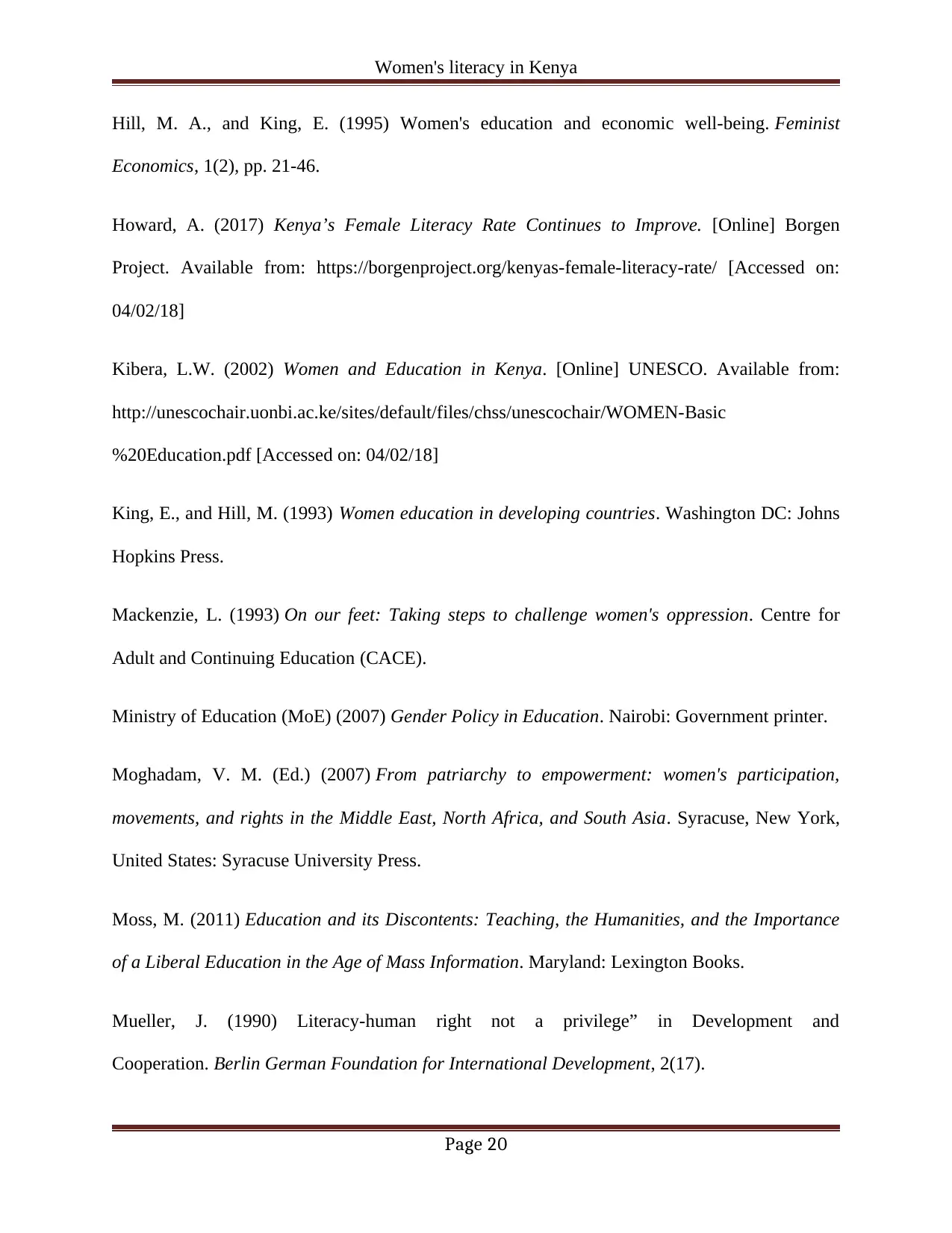
Women's literacy in Kenya
Hill, M. A., and King, E. (1995) Women's education and economic well-being. Feminist
Economics, 1(2), pp. 21-46.
Howard, A. (2017) Kenya’s Female Literacy Rate Continues to Improve. [Online] Borgen
Project. Available from: https://borgenproject.org/kenyas-female-literacy-rate/ [Accessed on:
04/02/18]
Kibera, L.W. (2002) Women and Education in Kenya. [Online] UNESCO. Available from:
http://unescochair.uonbi.ac.ke/sites/default/files/chss/unescochair/WOMEN-Basic
%20Education.pdf [Accessed on: 04/02/18]
King, E., and Hill, M. (1993) Women education in developing countries. Washington DC: Johns
Hopkins Press.
Mackenzie, L. (1993) On our feet: Taking steps to challenge women's oppression. Centre for
Adult and Continuing Education (CACE).
Ministry of Education (MoE) (2007) Gender Policy in Education. Nairobi: Government printer.
Moghadam, V. M. (Ed.) (2007) From patriarchy to empowerment: women's participation,
movements, and rights in the Middle East, North Africa, and South Asia. Syracuse, New York,
United States: Syracuse University Press.
Moss, M. (2011) Education and its Discontents: Teaching, the Humanities, and the Importance
of a Liberal Education in the Age of Mass Information. Maryland: Lexington Books.
Mueller, J. (1990) Literacy-human right not a privilege” in Development and
Cooperation. Berlin German Foundation for International Development, 2(17).
Page 20
Hill, M. A., and King, E. (1995) Women's education and economic well-being. Feminist
Economics, 1(2), pp. 21-46.
Howard, A. (2017) Kenya’s Female Literacy Rate Continues to Improve. [Online] Borgen
Project. Available from: https://borgenproject.org/kenyas-female-literacy-rate/ [Accessed on:
04/02/18]
Kibera, L.W. (2002) Women and Education in Kenya. [Online] UNESCO. Available from:
http://unescochair.uonbi.ac.ke/sites/default/files/chss/unescochair/WOMEN-Basic
%20Education.pdf [Accessed on: 04/02/18]
King, E., and Hill, M. (1993) Women education in developing countries. Washington DC: Johns
Hopkins Press.
Mackenzie, L. (1993) On our feet: Taking steps to challenge women's oppression. Centre for
Adult and Continuing Education (CACE).
Ministry of Education (MoE) (2007) Gender Policy in Education. Nairobi: Government printer.
Moghadam, V. M. (Ed.) (2007) From patriarchy to empowerment: women's participation,
movements, and rights in the Middle East, North Africa, and South Asia. Syracuse, New York,
United States: Syracuse University Press.
Moss, M. (2011) Education and its Discontents: Teaching, the Humanities, and the Importance
of a Liberal Education in the Age of Mass Information. Maryland: Lexington Books.
Mueller, J. (1990) Literacy-human right not a privilege” in Development and
Cooperation. Berlin German Foundation for International Development, 2(17).
Page 20

Women's literacy in Kenya
Mwiria, K. (1993) Kenyan women adult literacy learners: Why their motivation is difficult to
sustain. International Review of Education, 39(3), pp. 183-192.
Odhiambo, C. (2012) The name game: Using insults to illustrate the social construction of
gender. College Teaching, 60(1), pp. 25-30.
Republic of Kenya. (1988) Kenya Rural Literacy Survey, 1988: Basic Report. Nairobi:
Government Printer.
Schultz, P. (1993) Mortality decline in the low income world: Causes and consequences.
American economic review, 83(2), pp. 337-342.
Sen, P. (1999) Enhancing women’s choices in responding to domestic violence in Calcutta: A
comparison of employment and education. European Journal of Development Research, 11(2),
pp. 65-86.
Syomwene, A., and Kindiki, J. N. (2015) Women Education and Economic Development in
Kenya: Implications for Curriculum Development and Implementation Processes. Journal of
Education and practice, 6(15), pp. 38-43.
Tembon, M., and Fort, L. (2008) Girls Education in the 21st century: Gender equality,
empowerment and economic growth. Washington DC: World Bank
Thody, A. (2000) Educating Tomorrow: Lessons from Managing Girls' Education in Africa.
Sandton: Juta and Company Ltd.
UNESCO. (2012a) Education For All Global Monitoring Report. [Online] UNESCO. Available
from:
Page 21
Mwiria, K. (1993) Kenyan women adult literacy learners: Why their motivation is difficult to
sustain. International Review of Education, 39(3), pp. 183-192.
Odhiambo, C. (2012) The name game: Using insults to illustrate the social construction of
gender. College Teaching, 60(1), pp. 25-30.
Republic of Kenya. (1988) Kenya Rural Literacy Survey, 1988: Basic Report. Nairobi:
Government Printer.
Schultz, P. (1993) Mortality decline in the low income world: Causes and consequences.
American economic review, 83(2), pp. 337-342.
Sen, P. (1999) Enhancing women’s choices in responding to domestic violence in Calcutta: A
comparison of employment and education. European Journal of Development Research, 11(2),
pp. 65-86.
Syomwene, A., and Kindiki, J. N. (2015) Women Education and Economic Development in
Kenya: Implications for Curriculum Development and Implementation Processes. Journal of
Education and practice, 6(15), pp. 38-43.
Tembon, M., and Fort, L. (2008) Girls Education in the 21st century: Gender equality,
empowerment and economic growth. Washington DC: World Bank
Thody, A. (2000) Educating Tomorrow: Lessons from Managing Girls' Education in Africa.
Sandton: Juta and Company Ltd.
UNESCO. (2012a) Education For All Global Monitoring Report. [Online] UNESCO. Available
from:
Page 21

Women's literacy in Kenya
https://en.unesco.org/gem-report/sites/gem-report/files/EDUCATION_IN_KENYA_A_FACT_S
HEET.pdf [Accessed on: 04/02/18]
UNESCO. (2012b) UNESCO Global Partnership for Girls’ and Women’s Education - One Year
On. [Online] UNESCO. Available from:
http://www.unesco.org/eri/cp/factsheets_ed/KE_EDFactSheet.pdf [Accessed on: 04/02/18]
UNESCO. (2018) Education For All Movement. [Online] UNESCO. Available from:
http://www.unesco.org/new/en/education/themes/leading-the-international-agenda/education-for-
all/ [Accessed on: 04/02/18]
UNICEF. (2003) The state of the world’s children in 2004. New York: UNICEF.
UWEZO. (2010) Kenya National Learning Assessment report 2010. [Online] UWEZO.
Available from:
http://www.uwezo.net/wp-content/uploads/2012/08/KE_2010_AnnualAssessmentReportSummar
y.pdf [Accessed on: 04/02/18]
Wamahiu, S. P. (2011) Educate more girls today for a better Kenya. Talk presented at the Global
Action Week- Big Story Campaign at Milimani primary school, Nairobi on 6th May 2011.
Wanjohi, A.M. (2013) Challenges Facing Kenya in Achieving Education for All. [Online]
Kenpro. Available from: http://www.kenpro.org/challenges-facing-kenya-in-achieving-
education-for-all/ [Accessed on: 04/02/18]
World Bank Fact Sheet. (2007) Girl child education: A World Bank’s Priority. [Online] World
Bank Fact Sheet. Available from: http://go.worldbank.org/1L4BH3TG20 [Accessed on:
04/02/18]
Page 22
https://en.unesco.org/gem-report/sites/gem-report/files/EDUCATION_IN_KENYA_A_FACT_S
HEET.pdf [Accessed on: 04/02/18]
UNESCO. (2012b) UNESCO Global Partnership for Girls’ and Women’s Education - One Year
On. [Online] UNESCO. Available from:
http://www.unesco.org/eri/cp/factsheets_ed/KE_EDFactSheet.pdf [Accessed on: 04/02/18]
UNESCO. (2018) Education For All Movement. [Online] UNESCO. Available from:
http://www.unesco.org/new/en/education/themes/leading-the-international-agenda/education-for-
all/ [Accessed on: 04/02/18]
UNICEF. (2003) The state of the world’s children in 2004. New York: UNICEF.
UWEZO. (2010) Kenya National Learning Assessment report 2010. [Online] UWEZO.
Available from:
http://www.uwezo.net/wp-content/uploads/2012/08/KE_2010_AnnualAssessmentReportSummar
y.pdf [Accessed on: 04/02/18]
Wamahiu, S. P. (2011) Educate more girls today for a better Kenya. Talk presented at the Global
Action Week- Big Story Campaign at Milimani primary school, Nairobi on 6th May 2011.
Wanjohi, A.M. (2013) Challenges Facing Kenya in Achieving Education for All. [Online]
Kenpro. Available from: http://www.kenpro.org/challenges-facing-kenya-in-achieving-
education-for-all/ [Accessed on: 04/02/18]
World Bank Fact Sheet. (2007) Girl child education: A World Bank’s Priority. [Online] World
Bank Fact Sheet. Available from: http://go.worldbank.org/1L4BH3TG20 [Accessed on:
04/02/18]
Page 22
Secure Best Marks with AI Grader
Need help grading? Try our AI Grader for instant feedback on your assignments.

Women's literacy in Kenya
Page 23
Page 23
1 out of 23
Related Documents
Your All-in-One AI-Powered Toolkit for Academic Success.
+13062052269
info@desklib.com
Available 24*7 on WhatsApp / Email
![[object Object]](/_next/static/media/star-bottom.7253800d.svg)
Unlock your academic potential
© 2024 | Zucol Services PVT LTD | All rights reserved.





